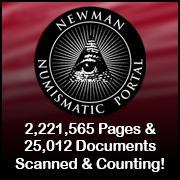
About UsThe Numismatic Bibliomania Society is a non-profit association devoted to the study and enjoyment of numismatic literature. For more information please see our web site at coinbooks.org SubscriptionsThose wishing to become new E-Sylum subscribers (or wishing to Unsubscribe) can go to the following web page link MembershipThere is a membership application available on the web site Membership Application To join, print the application and return it with your check to the address printed on the application. Print/Digital membership is $40 to addresses in the U.S., and $60 elsewhere. A digital-only membership is available for $25. For those without web access, write to: Terry White, Treasurer AsylumFor Asylum mailing address changes and other membership questions, contact Terry at this email address: terrywhite5475@yahoo.com SubmissionsTo submit items for publication in The E-Sylum, write to the Editor at this address: whomren@gmail.com BUY THE BOOK BEFORE THE COINSale Calendar |
- WAYNE'S WORDS: THE E-SYLUM NOVEMBER 4, 2018
- SELECTIONS FROM THE NEWMAN NUMISMATIC LIBRARY
- KOLBE & FANNING BUY OR BID SALE NUMBER 8
- NEW BOOK: SO-CALLED DOLLARS PACIFIC COAST EXPOS
- NEW BOOK: PAPER MONEY MESSAGES VOLUME 2
- BOOK REVIEWS: ANCIENT COIN BOOKS
- WES RASMUSSEN (1934-2018)
- NEWMAN PORTAL ADDS MORMON MONEY BOOKS
- SALMON AND GILL JOIN THE CCAC
- ANA SEEKS SPEAKERS, EXHIBITORS FOR PITTSBURGH SHOW
- NOTES FROM E-SYLUM READERS: NOVEMBER 4, 2018
- THE EMERGENCY MONEY OF LEIDEN
- MORE ON RISLEY & MCCOLLUM'S HIPPODROME TOKENS
- HYDRA IMAGES IN NUMISMATICS
- VOCABULARY TERMS: BLANKED, BLANKING
- JAMES GALEN (1840-1906)
- DENNIS TUCKER REMEMBERS J.T. STANTON
- HARVEY STACK'S NUMISMATIC FAMILY, PART 30
- BALDWIN HORSEMAN $10 STRUCK ON LARGE CENT
- JOHN PINCHES TWO-HEADED MORGAN DOLLARS
- ON THE MINT'S MANUFACTURED RARITIES
- ROYAL AUSTRALIAN MINT LAUNCHES TREASURE HUNT
- NOVEMBER 2018 MEDAL SELECTIONS FROM NUMISMAGRAM
- NUMISMATIC NUGGETS: NOVEMBER 4, 2018
- 2018 TEMPTATION OF THE SUCCUBUS
- MORE NEWMAN SALE X CURRENCY HIGHLIGHTS
- MORE NEWMAN SALE XI VOLUME 1 COIN HIGHLIGHTS
- MORE NEWMAN SALE XI VOLUME 2 LITERATURE HIGHLIGHTS
- GOLDBERG'S OFFERS RARE JUDAEAN MATERIAL
- AN 18TH CENTURY COIN FIND IN BULGARIA
- CULTURAL PROPERTY NEWS: LATEST COURT RESULTS
- ROYAL MINT PLANS BREXIT COIN
- EXECUTION SCENES IN NUMISMATICS
- PRESIDENT WOODROW WILSON MEDAL PUZZLE
- WAFFLE CANCELLED MARTHA WASHINGTON EXPERIMENTAL QUARTER
- SCIENTIST SOUGHT FOR BANK OF ENGLAND BANKNOTES
- NORWAY'S NEWEST PIXELLATED BANKNOTES
- BANKNOTE CUFFLINKS
Click here to access the complete archive a
Click here to unsubscribe (scroll down)
To comment or submit articles, reply to whomren@gmail.com
Content presented in The E-Sylum is not necessarily researched or independently fact-checked, and views expressed do not necessarily represent those of the Numismatic Bibliomania Society.
WAYNE'S WORDS: THE E-SYLUM NOVEMBER 4, 2018
 New subscribers this week include: Phil Beauchamp of the Pheli Mint; Glen Wilson, and Jeff Wing. Welcome aboard! We now have 5,779 subscribers.
New subscribers this week include: Phil Beauchamp of the Pheli Mint; Glen Wilson, and Jeff Wing. Welcome aboard! We now have 5,779 subscribers.
Thank you for reading The E-Sylum. If you enjoy it, please send me the email addresses of friends you think may enjoy it as well and I'll send them a subscription (but let me know if they are located in the European Union). Contact me at whomren@gmail.com anytime regarding your subscription, or questions, comments or suggestions about our content.
This week we open with selections from the upcoming Newman numismatic library sale, a Kolbe & Fanning Bid-or-Buy sale, two new books, a review, and a remembrance of large cent collector Wes Rasmussen.
Other topics this week include the emergency money of Leiden, hydra images in numismatics, collector and publisher James Galen, manufactured rarities from the U.S. Mint, more Eric P. Newman collection highlights, the Royal Mint's Brexit coin, and Norway's pixellated banknotes.
To learn more about Cogan's 1858 sale of U.S. cents, George Clapp's annotated Doughty, Mormon currency, how coin blanks are made, J.T. Stanton's “tighty-whiteysâ€, two-headed Morgan dollars, the Venice Film Festival Award medal, the temptation of the succubus, the the hefty howtizer, and banknote cufflinks, read on. Have a great week, everyone!
Wayne Homren
Editor, The E-Sylum
SELECTIONS FROM THE NEWMAN NUMISMATIC LIBRARY
The magnificent numismatic library of Eric P. Newman is being auctioned this week by Heritage. Here are some lots that caught my eye. For more, see another article on the sale later in this issue -Editor
Lot 15162 : Abel Brewster's Plan
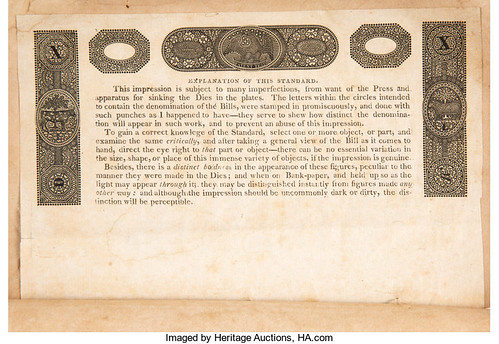
Brewster, Abel. A Plan for Producing an Uniformity in the Ornamental Part of Bank or Other Bills Where There Is Danger of Forgery, and for Furnishing the Public with a Convenient and Infallible Test for the Same... Philadelphia: Printed by Thomas Town, No. 3, Norris's Alley, 1810. 8vo, self-covered and stitched, as issued. 16, (2) pages; 1 finely engraved plate depicting ornamental bank note designs framing descriptive text relating to them. An extremely rare publication, virtually unknown to most of the collecting world. Eric P. Newman had acquired this copy by January 30, 1964, at which time he wrote about it to Dr. Julian Blanchard. It was reproduced in the Winter 1966 issue of the Essay-Proof Journal.
Brewster's pamphlet was published in direct competition with Jacob Perkins. Brewster states that Perkins had been trying to thwart his efforts in the area of bank note security by claiming infringement of patents, which Brewster considered baseless. Perkins had published his famous Bank Bill Test (also present in this sale) just the year before. Brewster's plate is very well printed, and he clearly understood the problems faced by bank note printers and had sound ideas about addressing them. It is also clear, however, that the battle was won by Perkins. Shaw & Shoemaker 19634. Worn and with some fraying at the edges; plate with some browning and light wrinkles, but better preserved than the text due to its smaller size. Good, with a very good plate. This may be the first time this work has been offered in the sale of a numismatic library. Estimate $2,000.
To read the complete lot description, see:
https://coins.ha.com/itm/books/brewster-abel-a-plan-for-producing-an-uniformity-in-the-ornamental-part-of-bank-or-other-bills-where-there-is-danger-of-forger/a/1283-15162.s
Lot 15196 : Original Subscription Set of Crosby
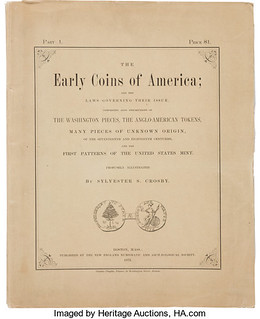 Crosby, Sylvester S. The Early Coins of America; and the Laws Governing Their Issue. Comprising Also Descriptions of the Washington Pieces, the Anglo-American
Tokens, Many Pieces of Unknown Origin, of the Seventeenth and Eighteenth Centuries, and the First Patterns of the United States Mint. Boston: Published by the New England
Numismatic and Archaeological Society, 1873 / Published by the Author, 1875. 4to [30.5 by 24.5 cm], as originally issued in 11 fascicules numbered 1-12 with printed paper covers.
1873 and 1875 title pages and introductions present. (2), v, (5), 11-381, (1) pages [different pages (2), v, (1), comprising the revised title and introduction, laid into
Fascicule 11-12]; 110 wood engravings in the text; 2 folding heliotype manuscript facsimiles; 10 fine heliotype plates of coins and tokens. Housed in a black cloth slipcase.
Crosby, Sylvester S. The Early Coins of America; and the Laws Governing Their Issue. Comprising Also Descriptions of the Washington Pieces, the Anglo-American
Tokens, Many Pieces of Unknown Origin, of the Seventeenth and Eighteenth Centuries, and the First Patterns of the United States Mint. Boston: Published by the New England
Numismatic and Archaeological Society, 1873 / Published by the Author, 1875. 4to [30.5 by 24.5 cm], as originally issued in 11 fascicules numbered 1-12 with printed paper covers.
1873 and 1875 title pages and introductions present. (2), v, (5), 11-381, (1) pages [different pages (2), v, (1), comprising the revised title and introduction, laid into
Fascicule 11-12]; 110 wood engravings in the text; 2 folding heliotype manuscript facsimiles; 10 fine heliotype plates of coins and tokens. Housed in a black cloth slipcase.
An original subscription set of Crosby's masterpiece, the foundation upon which all subsequent works on early American coinage have been built. Entirely in its original state. The Early Coins of America was not intended to be the work of Crosby alone. Appointed the head of a committee of six by the New England Numismatic and Archaeological Society and charged with publishing a work on early American coinage, Crosby soon found himself alone in the pursuit. Not only was the research and composition of the work done almost entirely by Crosby, ultimately he also had to publish it. The 12 parts (as issued in 11) were published separately and distributed to subscribers in printed wraps: it was left to the subscriber to eventually bind his or her copy upon completion. Very few sets remain extant as here in their original state.
State with overprinted coin numbers on Plates IV and V (see Eric P. Newman's "Bibliographical Foreword" to the 1983 Quarterman reprint for information on plate states). Coin 15a on Plate VII hand-numbered in pencil, apparently as always. Without the handwritten correction, occasionally seen, to Miss Eliza Susan Quincy's name in the subscribers' list on page 381. Clain-Stefanelli 12115*. Davis 291. Grierson 218. Sigler 603. Parts 11 & 12, as issued in one fascicule, with detached (but present) front cover. Generally an exceptionally fine, well-preserved set. Estimate $12,000
Wow. These unbound subscription sets are scarce as hen's teeth and a centerpiece of any library of American numimatic literature. A great prize for the winning bidder. -Editor
To read the complete lot description, see:
https://coins.ha.com/itm/books/crosby-sylvester-s-the-early-coins-of-america-and-the-laws-governing-their-issue-comprising-also-descriptions-of-the-washing/a/1283-15196.s
Lot 15203 : George Clapp's Annotated Doughty
 Doughty, Francis Worcester. The Cents of the United States: A Numismatic Study. Extensively Illustrated from Selected Specimens. New York: Scott, 1890. 8vo, original
olive-brown cloth, elaborately decorated and lettered in gilt, depicting a 1793 Flowing Hair large cent. (6), 115, (1) pages; text figures; 2 tables (1 folding); 4 lithographic
plates of coins. Very good. Heavily annotated throughout in pencil by George H. Clapp with numerous inserts laid in, including: two handwritten letters from Charles Clapp on
Classic Head large cents; two typewritten studies of 1808 cents by S.H. Chapman; one handwritten letter by George Henry Davis also on Classic Head cents; a typewritten letter by
James Macallister; two handwritten letters from Howard R. Newcomb, both on large cents, one of them continuing onto a second sheet; a number of inserted notes written by George H.
Clapp; 4 pages of handwritten commentary by George Clapp on 1808 cent varieties; several rubbings and impressions of large cents; a printed advertisement for the Doughty book; and
a Lyman Low circular signed by Frank Higgins. Previously in the library of Frank C. Higgins, with his bookplate; signed on the front blank by Higgins and dated 1899; signed by
George H. Clapp on the same blank, dated 1921, below which Clapp has written: "The notes on margins in this book are the beginnings of my revision of these early
dates."
Doughty, Francis Worcester. The Cents of the United States: A Numismatic Study. Extensively Illustrated from Selected Specimens. New York: Scott, 1890. 8vo, original
olive-brown cloth, elaborately decorated and lettered in gilt, depicting a 1793 Flowing Hair large cent. (6), 115, (1) pages; text figures; 2 tables (1 folding); 4 lithographic
plates of coins. Very good. Heavily annotated throughout in pencil by George H. Clapp with numerous inserts laid in, including: two handwritten letters from Charles Clapp on
Classic Head large cents; two typewritten studies of 1808 cents by S.H. Chapman; one handwritten letter by George Henry Davis also on Classic Head cents; a typewritten letter by
James Macallister; two handwritten letters from Howard R. Newcomb, both on large cents, one of them continuing onto a second sheet; a number of inserted notes written by George H.
Clapp; 4 pages of handwritten commentary by George Clapp on 1808 cent varieties; several rubbings and impressions of large cents; a printed advertisement for the Doughty book; and
a Lyman Low circular signed by Frank Higgins. Previously in the library of Frank C. Higgins, with his bookplate; signed on the front blank by Higgins and dated 1899; signed by
George H. Clapp on the same blank, dated 1921, below which Clapp has written: "The notes on margins in this book are the beginnings of my revision of these early
dates."
An extraordinary volume. The Doughty work is not terribly well appreciated in our day, as it is generally regarded as little more than a compilation of existing research (most of it conducted by David Proskey)--which is true, but this particular copy of Doughty is the most exciting large cent book we have encountered in years. The commentary in the annotations is thorough and rigorous, as is all of Clapp's writing. He was not one to suffer fools gladly, and his comments on Doughty's work are not infrequently harsh, but this book has far more to offer than entertainment value. It would be important even if it hadn't a single inserted item--but it does, and the letters and other inserted notes are also substantive and important. The letters from Newcomb in particular show the level of cooperation between these two researchers and their mutually held trust and respect. The letters from Charles Clapp show quite clearly that his knowledge and observations have been underappreciated over the years, overshadowed as he was by his brother. This is a wonderful item and is one of the highlights of the Eric P. Newman library. Estimate $5,000.
A unique and important item - you can't get much closer to numismatic history than this. -Editor
To read the complete lot description, see:
https://coins.ha.com/itm/books/doughty-francis-worcester-the-cents-of-the-united-states-a-numismatic-study-extensively-illustrated-from-selected-specimens/a/1283-15203.s
Lot 15232 : Hall's List of the Connecticut Coppers
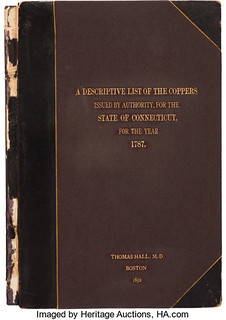 Hall, Thomas. A Descriptive List of the Coppers Issued by Authority, for the State of Connecticut, for the Year 1787. Boston: Privately printed, for additions and
corrections, 1892. 8vo, original black half calf, gilt, with brown cloth sides; upper cover lettered in gilt. 58 pages. First 16 pages with corresponding reverse page numbers
filled in by hand in ink.
Hall, Thomas. A Descriptive List of the Coppers Issued by Authority, for the State of Connecticut, for the Year 1787. Boston: Privately printed, for additions and
corrections, 1892. 8vo, original black half calf, gilt, with brown cloth sides; upper cover lettered in gilt. 58 pages. First 16 pages with corresponding reverse page numbers
filled in by hand in ink.
Hall's rare work was intended to be distributed among a select circle of fellow collectors. With the benefit of their comments and additions to the list, a final version of the work was to be published--but it never reached fruition. The original leather binding used poor materials and most copies are either rebound or (as here) in well-worn condition. Spine worn and chipped. Contents very good or better. Estimate $2,000.
A classic rarity. -Editor
To read the complete lot description, see:
https://coins.ha.com/itm/books/hall-thomas-a-descriptive-list-of-the-coppers-issued-by-authority-for-the-state-of-connecticut-for-the-year-1787/a/1283-15232.s
Lot 15323 : BEP Specimen Scrapbook
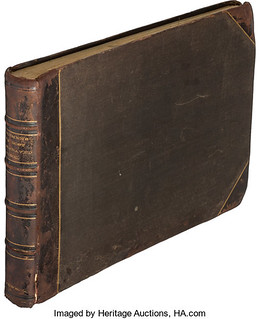
[Jewell, H.C.]. Specimens and Cost of Engraved Work. Spine title cited. Scrapbook of finely engraved portraits, vignettes, and bank note design elements, assembled for the use of Bureau of Engraving and Printing Chief Henry C. Jewell, possibly by BEP Chief Engraver George W. Casilear, c. 1876-1877. Oblong 4to, original brown half morocco, gilt; spine with four raised bands, ruled and lettered in gilt, with H.C. JEWELL impressed in gilt at the base of the spine. Approximately 60 leaves, interleaved with ruled paper. Of these, 25 leaves have various finely engraved portraits, vignettes, bank note elements, and related designs affixed to them. There is a total of 11 portraits, 8 vignettes, and 143 design elements. No text accompanies the engravings.
An intriguing scrapbook with some exceptionally well-rendered engraved design elements, many of them made for bank notes and bonds. Beyond the spine lettering, there is no text to assist us in determining the context in which this book was assembled. A very interesting letter from Raphael Ellenbogen to Eric P. Newman, dated October 28, 1996, attempts to shed some light on the matter, and speculates that the book was compiled by George W. Casilear between 1865 and 1870, but this is not entirely accurate. At least two of the engravings make reference to committees planning for the U.S. Centennial in 1876, and one is dated 1872, giving us the earliest date at which it was likely to have been made. Given that Jewett served as Chief of the BEP only in 1876 and 1877, it seems safe to assign the production of this volume to those years. It was clearly not intended for special presentation, as the binding is fairly ordinary and the spine lettering points to a purely practical function. While the binding is rubbed and worn at the extremities, the engravings are clean and crisp. A lovely book.
A trophy for the collector with an interest in art and engraving. -Editor
To read the complete lot description, see:
https://coins.ha.com/itm/books/-jewell-hc-specimens-and-cost-of-engraved-work/a/1283-15323.s
Lot 15404 : The Case, Trevett against Weeden
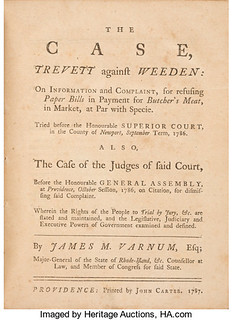 Varnum, James M. The Case, Trevett against Weeden: On Information and Complaint, for Refusing Paper Bills in Payment for Butcher's Meat, in Market, at Par
with Specie. Tried before the Honourable Superior Court, in the County of Newport, September Term, 1786... Providence: Printed by John Carter, 1787. 8vo, somewhat later red
quarter straight-grained morocco with marbled sides; spine lettered and decorated in gilt. (4), 60 pages. Very rare. Evans 20825. Sabin 98638. Binding quite worn, with spine
covering mostly lacking and front cover detached, but present. Pages a little browned, but generally very good or better. Estimate $600.
Varnum, James M. The Case, Trevett against Weeden: On Information and Complaint, for Refusing Paper Bills in Payment for Butcher's Meat, in Market, at Par
with Specie. Tried before the Honourable Superior Court, in the County of Newport, September Term, 1786... Providence: Printed by John Carter, 1787. 8vo, somewhat later red
quarter straight-grained morocco with marbled sides; spine lettered and decorated in gilt. (4), 60 pages. Very rare. Evans 20825. Sabin 98638. Binding quite worn, with spine
covering mostly lacking and front cover detached, but present. Pages a little browned, but generally very good or better. Estimate $600.
Ex: Charles I. Bushnell, with his bookplate.
To read the complete lot description, see:
https://coins.ha.com/itm/books/varnum-james-m-the-case-trevett-against-weeden-on-information-and-complaint-for-refusing-paper-bills-in-payment-for-butcher/a/1283-15404.s
To read earlier E-Sylum article, see:
NEWMAN SALE XI VOLUME 2 LITERATURE HIGHLIGHTS (http://www.coinbooks.org/v21/esylum_v21n43a18.html)
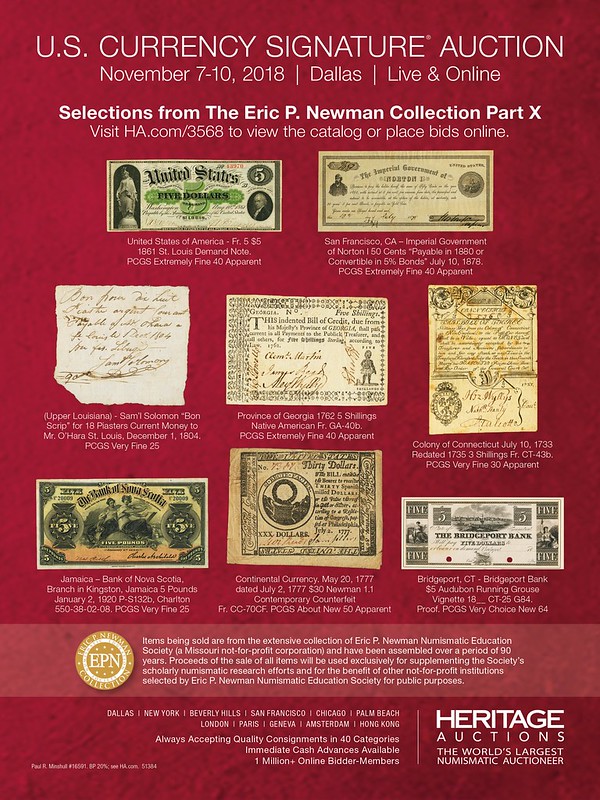
KOLBE & FANNING BUY OR BID SALE NUMBER 8
Numismatic Booksellers Kolbe & Fanning submitted this announcement of their eighth “Buy or Bid Sale†which closes on November 14, 2018. Good luck, everyone! -Editor
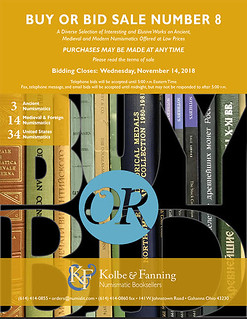 Kolbe & Fanning Numismatic Booksellers have announced their eighth “Buy or Bid Sale,†which begins now and will close on Wednesday, November 14. The sale focuses on
modestly priced books, giving collectors an opportunity to add to their libraries at minimal cost.
Kolbe & Fanning Numismatic Booksellers have announced their eighth “Buy or Bid Sale,†which begins now and will close on Wednesday, November 14. The sale focuses on
modestly priced books, giving collectors an opportunity to add to their libraries at minimal cost.
There will be no printed catalogue. The PDF catalogue is available now for downloading from the Kolbe & Fanning website at numislit.com.
As the name of the sale suggests, customers may bid on items they wish to acquire or buy them outright at the published price. The Terms of Sale will give full instructions on how to participate: please read it carefully.
The sale includes over 1300 works on ancient, medieval and modern coins, as well as general works, periodicals and sale catalogues. “Buy†prices have been kept low to promote sales. To further encourage participation, the firm is offering free domestic shipping to bidders spending at least $300; there will also be no packing and processing fee for this sale. Again, please read the Terms of Sale before participating.
Please send all bids to orders@numislit.com or use the bid sheet included at the end of the PDF catalogue.
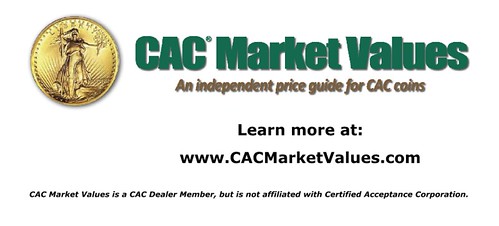
NEW BOOK: SO-CALLED DOLLARS PACIFIC COAST EXPOS
Here's the press release for a new book on So-Called Dollars by Jeff Shevlin and Bill Hyder. -Editor
So-Called Dollars from the Pacific Coast Expositions
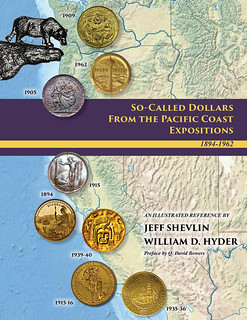 So-Called Dollar dealer Jeff Shevlin and William D Hyder announced the release of their new book, So-Called Dollars from the Pacific Coast Expositions. It is an
illustrated reference and is the second in a series of books Shevlin plans to publish to redefine and expand the field of collecting So-Called Dollars. Preface by Q. David
Bowers.
So-Called Dollar dealer Jeff Shevlin and William D Hyder announced the release of their new book, So-Called Dollars from the Pacific Coast Expositions. It is an
illustrated reference and is the second in a series of books Shevlin plans to publish to redefine and expand the field of collecting So-Called Dollars. Preface by Q. David
Bowers.
Shevlin and co-author William D. Hyder share the stories, history and events of the expositions that were held on the Pacific Coast. From the 1894 California Midwinter Exposition through the 1962 Seattle World’s Fair there were eight major expositions held on the Pacific Coast. The heart of the book is the in depth analysis of all of the So-Called Dollars, historical U.S. medals, associated with those great expositions. Dozens of previously unknown medals and varieties are identified that will help collectors interested in this fascinating series of historical medals.

- 1894 California Midwinter Exposition
- 1905 Lewis and Clark Exposition
- 1909 Alaska-Yukon-Pacific Exposition
- 1915 Panama Pacific International Exposition
- 1915-16 Panama–California Exposition
- 1935-36 California Pacific International Exposition
- 1939-40 Golden Gate International Exposition
- 1962 Seattle World’s Fair
So-called dollars are historical U.S. medals that commemorate a person, place or event in the United States history. They are 33mm to 45mm in size.
Hardbound editions with over 300 full color pages, 81/2 x 11, are $59.95. A very special signed and numbered collector’s edition with a medal encased in the cover, limited to 95 copies, is available for $95. Shipping is $4.50 per book.
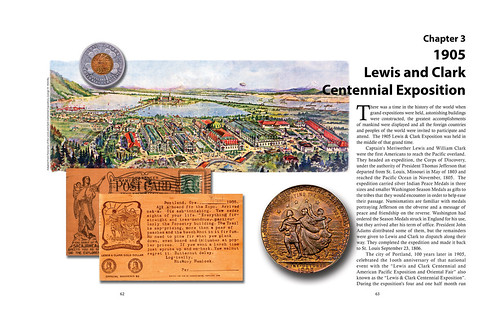
To order your book contact:
Jeff Shevlin, the So-Called Guy
1894 E. Willian St., Suite 4-240
Carson City, NV 89701
Phone: (916) 955-2569
Email: SoCalledGuy@Hotmail.com
http://So-CalledDollar.com
NEW BOOK: PAPER MONEY MESSAGES VOLUME 2
I don't believe we were aware of Volume 1 of Jeffrey Wing's book when it debuted in January 2017. I came across the book's web site this week and discovered a Volume 2 was just published in June 2018. This volume focuses on German Notgeld (Emergency Money), where the first volume covered the world. A planned third volume "will focus on Paper Money that is Christian themed." Here is information from the web site and Amazon. The price is $49.99. -Editor
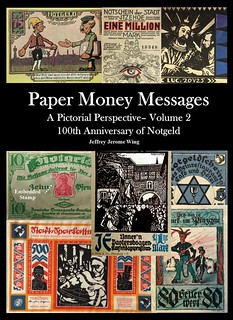 This Volume 2 continues the author’s intriguing account of paper money, focusing on the German notgeld used for emergency currency in the early 1900s. Notgeld is
particularly interesting for the imagery and text used in its design, which will connect the reader to a broad range of historical subjects, such as the hyperinflationary period
that struck Germany between 1914 and 1924 and the struggles of the Jewish people in that country and others.
This Volume 2 continues the author’s intriguing account of paper money, focusing on the German notgeld used for emergency currency in the early 1900s. Notgeld is
particularly interesting for the imagery and text used in its design, which will connect the reader to a broad range of historical subjects, such as the hyperinflationary period
that struck Germany between 1914 and 1924 and the struggles of the Jewish people in that country and others.
The author uses the notgeld to explain the devastation of the German economy when the price of goods increased by the hour and for instance a 1,000,000,000,000-mark note had the value of only 22 cents (U.S.)! Many of the notgeld seen in this book was used by the Nazis for propaganda against the Jews and expressed the anti-Semitism so prevalent in that day. Battles, witches, spirits, Christianity, miracles, and the Catholic Church are some of the many themes expressed by the notgeld artwork and the associated text. The reader will find this abundantly-illustrated book to be rich in history and a rewarding study of paper money.
Amazon review by Steijn (5 Stars):
This is a lavishly-produced and intelligent review of the subjects and symbolism found on German "Notgeld" banknotes of the hyperinflation period. Given that the catalog of such notes runs to many volumes, a book like this can really only show a sample and point the way, but the book does so very, very well. There are so many hidden messages, jokes and complaints in these notes that you can study them for decades and still find surprises.
Printed on high-quality paper and in full color throughout, this is a book you don't just park on your coffee table, you read and reread it over and over again. A great addition to your "Notgeld" library and an essential book if you are interested in what the German national mood really was while their currency's value evaporated. Highly recommended!
Amazon review by Tony (5 Stars):
This 2nd volume in the ‘Paper Money Messages’ series by Jeff Wing, specialises in German notgeld (emergency money issues). There is a whole story to be told about notgeld and Jeff has really done an excellent job here. The imagery on the depicted notgeld issues are superb and illustrate the different and varied points being made throughout the publication. The many different topics and themes depicted on the notgeld are discussed with great enthusiasm and research has obviously been actioned with great diligence.
The author obviously has a real passion for banknotes and notgeld issues and that oozes from the narrative. The hidden messages of the graphics and texts are explored in great detail and the reader is slowly drawn into an historical web of feelings, beliefs and out-cryings. This is a ‘must-buy’ for any passionate banknote and notgeld collector. Superb in presentation and depictions, you will not be disappointed. You will learn a lot from this book and the notgeld will become even more interesting as a result.
About the Author Paper Money Messages, a Pictorial Perspective (Vol 1 and 2) is a result of Jeffrey J. Wing’s journeys over the past twenty years to more than thirty countries, including particularly those to some of the world’s poorest countries. Volunteering with Engineering Ministries International (EMI) and TransformAsia in Cambodia, he has used his engineering skill to assist the Christian organizations in the development of schools, orphanages, and hospitals in those countries.
Jeffrey’s interest in paper money originated from these diverse travels when he began to collect local currencies. Experiencing a country that had faced economic and political turmoil made him reevaluate the true value of paper money. In addition, he recognized that the imagery on a nations currency was often a significant reflection of that nation’s history and value system.
More and more Jeffrey realized the importance that a book about paper money might have to those with not only a general interest in currency but the subject would have a much wider appeal, extending to persons with an appreciation of the money’s colorful imagery or to students of history. Jeffrey resides in Raleigh North Carolina, with his wife, Christy, and children Reese and Hannah.
Product details
Paperback: 242 pages
Publisher: CreateSpace Independent Publishing Platform; 1 edition (April 17, 2018)
Language: English
ISBN-10: 1981161368
ISBN-13: 978-1981161362
Product Dimensions: 8.5 x 0.6 x 11 inches
Shipping Weight: 1.6 pounds
For more information, or to order, see:
https://papermoneymessages.com/
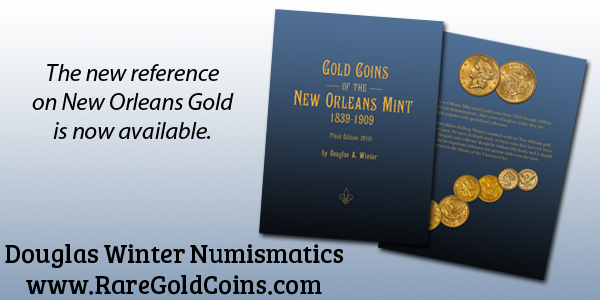
BOOK REVIEWS: ANCIENT COIN BOOKS
On October 30, 2018 Mike Markowitz published a CoinWeek article recommending a group of coin books for beginning collectors of ancient coins. He made some great choices. Here's a short excerpt - see the complete article online. -Editor
The best advice this or any other coin collector ever got is, “Buy the book before you buy the coin.â€
For beginning collectors of early and modern American coins, the choice of reference books is simple. If you have The Official Red Book®, you’re probably good to go. With 463 compact pages of comprehensive, reliable information — at a list price of just $17.95, the Red Book is a no-brainer.
Collectors of ancient coins face a more daunting task.
Ancient coins come in tens of thousands of types, with hundreds of “issuing authorities†(empires, cities, tribes, and rulers) and the books that document all this information represent centuries of accumulated scholarship — not all of it in English. Ancient coin books can be costly, and hard to find.
In general terms, ancient coins fall into two broad categories: Roman and “Greek.†For convenience, coins issued by many peoples who spoke Semitic, Celtic, Central Asian and other languages are lumped into the “Greek†category.
CoinWeek asked me to recommend five books that might make up a beginner’s reference library for classical numismatics. But as J.R.R. Tolkien used to say, the tale grew in the telling…
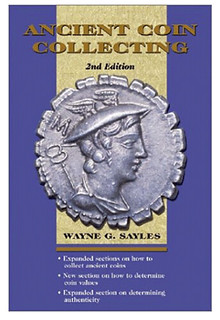 If you’re not quite sure where to start, the best first choice is Ancient Coin Collecting by Wayne Sayles. With a list price of about $22, the second
edition delivers 312 pages of solid advice, with over 300 photographs and many charts and tables. As one reviewer noted, “I wish I had this book twenty years ago when I began
collecting.†Other titles by the same author cover Greek, Roman, Byzantine, and other coins, plus Classical Deception, the best non-technical book on counterfeit ancients. If
these are the only ancient coin books you ever buy, you will be glad you did.
If you’re not quite sure where to start, the best first choice is Ancient Coin Collecting by Wayne Sayles. With a list price of about $22, the second
edition delivers 312 pages of solid advice, with over 300 photographs and many charts and tables. As one reviewer noted, “I wish I had this book twenty years ago when I began
collecting.†Other titles by the same author cover Greek, Roman, Byzantine, and other coins, plus Classical Deception, the best non-technical book on counterfeit ancients. If
these are the only ancient coin books you ever buy, you will be glad you did.
To read the complete article, see:
Ancient Coin Books: A Collector’s Reference
Library for Classical Numismatics (https://coinweek.com/recent-articles-video/ancient-coin-books-a-collectors-reference-library-for-classical-numismatics/)
WES RASMUSSEN (1934-2018)
Pete Smith submitted this remembrance of large cent specialist Wes Rasmussen. Thank you! The top photo is from the Heritage sale of Rasmussen's collection. -Editor
(10/5/1934 – 11/2/2018)
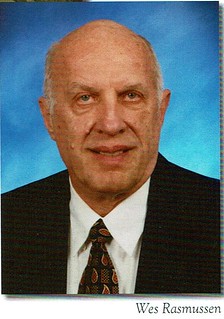 I met Wes Rasmussen in the early 1980’s through our mutual friend, Dick Punchard. The three of us became the Minnesota contingent to EAC conventions and travelled
together to California copper auctions including Phil Van Cleave (1986), Robbie Brown (1986) and Jack Robinson (1989). On a couple of our trips we were joined by Bob and Tom
Matthews.
I met Wes Rasmussen in the early 1980’s through our mutual friend, Dick Punchard. The three of us became the Minnesota contingent to EAC conventions and travelled
together to California copper auctions including Phil Van Cleave (1986), Robbie Brown (1986) and Jack Robinson (1989). On a couple of our trips we were joined by Bob and Tom
Matthews.
When Wes bid at auction, he was not just interested in adding to his collection. It was a competition and he did not like to lose. There were times when I saw two large egos with deep pockets go up against each other. The result may have been a sale price well above current market value.
Wes was in the printing business doing general commercial printing with Litho-Tech Services. I recall that they specialized in printing vinyl covers for loose leaf binders. In 1986 Wes arranged for Litho-Tech to print and distribute Penny-Wise to members of EAC.
Litho-Tech printed the Attribution Guide for United States Large Cents 1840-1857 by J. R. Grellman and Jules Reiver (1986). The two-volume set had a printed vinyl cover.
Litho-Tech also printed Bill Noyes’ book on large cents. In 1991 I traveled with Bill Daehn to Chicago for the ANA convention. We packed up 100 copies of the book in Bill’s car to deliver to the show in Chicago.
Litho-Tech published the John Wright book on middle date cents in 1992. They continued to publish Penny-Wise until 2005. The company was sold to Glen Taylor, owner of the Minnesota Timberwolves.
Wes was active with the Lions Club and served as president of the local chapter. He asked me to speak about Colonial coins at one of their lunch meetings. I learned about the Lion’s tail twister but don’t think he would do well at a coin club meeting.
Canterbury Downs opened as a Minnesota race track in 1985 and the state promoted horse racing as an industry. Wes hopped in the saddle as a horse owner (not as a rider). I don’t recall if he won any races as owner.
I frequently visited him in Bloomington, Minnesota, in a large house on the bluff overlooking the Minnesota River. Wes enjoyed watching deer and other animals in the parkland below. When Wes was considering a move to Las Vegas, he and his wife, Judy, wanted to stay in Minnesota until their daughter Kathy was married. Wes wanted to see his daughter coming down the grand staircase in her wedding gown.
I didn’t see much of Wes after he moved to Las Vegas in the 1990’s. He served as president of EAC from 1996 to 1999 and as host of the EAC convention in 1997 and again in 2002 with Al Boka and Jeff Gresser. I don’t know how much he was a gambler. I know that he collected casino chips and was an active member of the “Silver Strikersâ€.
In 2005 I attended the FUN show with my employer. The Heritage sale of the Wes Rasmussen collection was held at the same time. I greeted Wes and Judy and a lot of old EAC friends at the sale. I had my eye on a couple of coins but was not a successful bidder.
In June of 2010 I went to Las Vegas for the CC>CC convention. I was surprised to see that Wes had a table there. He was selling ten ounce silver rounds from casinos. As the show was closing I talked with him about his success at the show. He said that sometimes you can buy your way out of a show. Apparently his purchases were better than his sales.
Judy died on October 29, 2016, after sixty years of marriage. Wes moved to Wisconsin, at least for the summers, but continued to visit Las Vegas. It was on one of these visits in October that he suffered a stroke and did not recover.
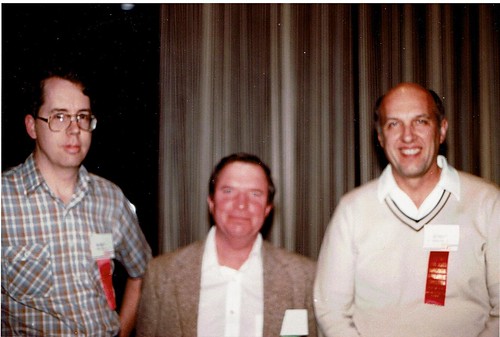
Pete Smith, Dick Punchard and Wes Rasmussen at the 1986 Philip Van Cleave sale; photo courtesy Kagin's via Pete Smith

NEWMAN PORTAL ADDS MORMON MONEY BOOKS
The latest additions to the Newman Numismatic Portal are two books by Doug Nyholm on Mormon currency. Project Coordinator Len Augsburger provided the following report. -Editor
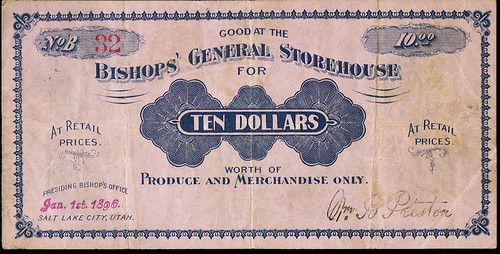
Mormon Currency, 1837-1937 and Updates & Short Stories Added to Newman Portal
Author Douglas Nyholm has released two volumes related to Mormon numismatics for publication on Newman Portal. Mormon Currency, 1837-1937 (2nd edition, 2015) begins with the 1837 Joseph Smith-signed notes of the Kirtland (OH) Safety Society Bank. Interestingly, the Smith signature is desirable even though many examples are thought to have been signed by Smith’s “scribes†and not Smith personally. Notes are also signed by other Mormon church dignitaries.
Mormon paper money follows the migration of the church from east to west, including bank notes of Monroe, MI and scrip from Nauvoo, IL. From here Nyholm moves to the more well-known gold coinage of the Gold Rush era. To complement the gold pieces, a host of scrip and small-denomination currency continued to be issued. This portion of the catalog is the most valuable contribution of the book, illustrating and detailing hundreds of emissions. The overall work is indispensable for collectors of Mormon numismatics, and will be the standard reference for some time. The NLG named this work the Best Book on U.S. Currency for 2010.
Doug Nyholm has also released a companion volume, Updates & Short Stories About Mormon Currency (2018). This work contains a variety of supplementary material including historical essays, grading, trial strikes, and a review of the Eric P. Newman collection of Mormon scrip, several examples of which sold at the 5-figure level. The Bishop’s General Storehouse $10, pictured here, sold for an astounding $25,850 (Newman VII, 10/2015, lot 18616). Prior to the Newman sale, Nyholm speculated the Bob & Carol Campbell example was the only such piece held privately.
Link to Mormon Currency (2nd edition, 2015) on Newman Portal:
https://nnp.wustl.edu/library/book/556921
Link to Updates & Short Stories About Mormon Currency (2018) on Newman Portal
https://nnp.wustl.edu/library/book/556922
SALMON AND GILL JOIN THE CCAC
In a press release this week the U.S. Mint announced two new appointees to the Citizens Coinage Advisory Committee. -Editor
The United States Mint is pleased to announce the appointment of two new members to the Citizens Coinage Advisory Committee (CCAC). The two new members will fill the vacancies created by the expiration of appointments.
Samuel H. Gill was appointed to represent the interests of the general public, replacing Kareem Abdul-Jabbar. Mr. Gill is a transportation, logistics, and supply chain technology expert who has run his own consulting business for more than 20 years. Mr. Gill is a former executive at the American Trucking Associations in Alexandria, Virginia, and started his career with Arthur Andersen and Company in Washington D.C. He is a certified public accountant and has been an avid coin collector since childhood.
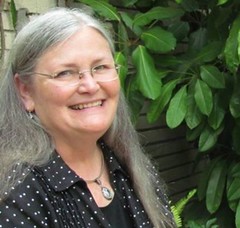 Robin Salmon was appointed as the member specially qualified in medallic art and sculpture, replacing Heidi Wastweet. A native of Columbia, South Carolina, Ms. Salmon
has been on the staff of Brookgreen Gardens, a sculpture garden and wildlife preserve located just south of Murrells Inlet, in South Carolina, since 1975. She oversees the
acquisition, exhibition, and conservation of Brookgreen’s art, history, library, and archives collections, and directs the activities of the Carroll A. Campbell, Jr. Center
for American Sculpture, bringing prominent sculptors to Brookgreen annually for residencies, lectures, and workshops.
Robin Salmon was appointed as the member specially qualified in medallic art and sculpture, replacing Heidi Wastweet. A native of Columbia, South Carolina, Ms. Salmon
has been on the staff of Brookgreen Gardens, a sculpture garden and wildlife preserve located just south of Murrells Inlet, in South Carolina, since 1975. She oversees the
acquisition, exhibition, and conservation of Brookgreen’s art, history, library, and archives collections, and directs the activities of the Carroll A. Campbell, Jr. Center
for American Sculpture, bringing prominent sculptors to Brookgreen annually for residencies, lectures, and workshops.
Congratulations, and good luck. I added a portrait of Robin Salmon found on the web. -Editor
For more information on the Citizens Coinage Advisory Committee, see:
https://www.ccac.gov/
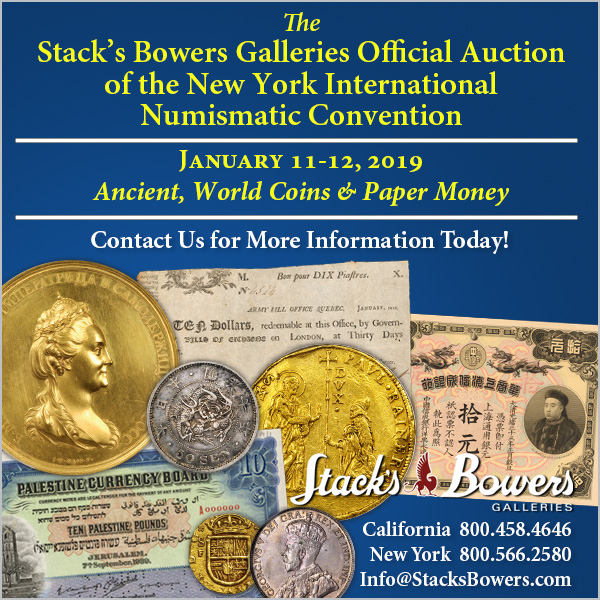
ANA SEEKS SPEAKERS, EXHIBITORS FOR PITTSBURGH SHOW
The American Numismatic Association is recruiting exhibitors and speakers for the Pittsburgh National Money Show March 28-30, 2019. Who better than E-Sylum readers, the smartest bunch of collectors around! How about some numismatic literature exhibits? -Editor
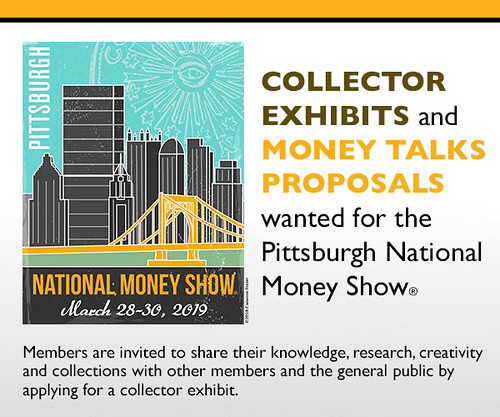
APPLICATIONS. Exhibitors must file a separate application for each exhibit, designating the group and classification in which it will be entered. Exhibit applications must reach the ANA no later than January 18, 2019.
EXHIBIT TEXT GUIDELINES. Exhibitors, in preparing their texts, may choose to use information verbatim from one or more sources. For details judged as “basic numismatic information,†such as mintage, designer, composition, etc., it is sufficient that sources for such information will be shown in a list of references. For text relating more to “special numismatic information,†such as historical, biographical, or economic matters, it is best for exhibitors to present information in their own words. Text or illustrations lifted directly from other sources should be directly attributed to those sources. Instances where material is presented as “original†that has been copied from other sources will result in significant point deductions.
For an application and rules, see:
Exhibit Application
(https://www.money.org/uploads/2019%20PIT%20Exhibits%20Application.pdf)
Exhibit Rules (https://www.money.org/uploads/2019%20PIT%20Exhibits%20Rules.pdf)

ANA Money Talks presentations are 30- to 45- minute programs, including questions from the audience, and should include a digital presentation. They are scheduled on the hour.
A brief description of your presentation as well as a brief biography is required and these items must be submitted with your proposal form. This information is used to promote your talk and for your introduction.
The following equipment will be provided: a laptop computer (Windows, Office, and PowerPoint 2007), a digital projector, a projector screen, a laser pointer, and one exhibit case.
To submit a proposal, see:
https://www.money.org/numismatic-events/money-talks#form

NOTES FROM E-SYLUM READERS: NOVEMBER 4, 2018
Cogan's 1858 Sale of U.S. Cents
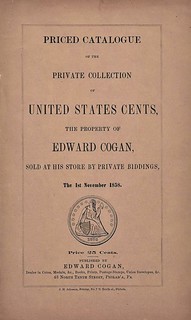 Earlier this week Jim Neiswinter wrote:
Earlier this week Jim Neiswinter wrote:
160 years ago today, Nov. 1, 1858, was the first Ed Cogan sale. The 77 cents realized $128.68. The result of this sale was published in Philadelphia newspapers and was credited by Cogan as "the chief cause of the unprecedented demand that arose for obtaining coins."
Thanks! A landmark event. -Editor
Another Brasher Doubloon Electrotype
Bob Marcus of Chapel Hill, North Carolina writes:
I discovered with great interest the Stack’s Baltimore sale this week of the Dubois Brasher electrotype (circa 1860). I was greatly impressed by Craig Sholley’s communication to The E-Sylum displaying great knowledge. Then following carefully considers my careful examination of the original on exhibit in the Smithsonian Institution (slide by side) and the photos of the electrotype just sold.
I own what I am 100 percent certain is an electrotype of the doubloon made by Dubois from the original, circa 1860. My example is identical in every respect (save one). Briefly, it exhibits the scratches, weaknesses, depressions, etc. that are present on both the aforementioned genuine example in the Smithsonian and the electrotype just sold this past week. The distinction is that the electrotype I own is fully gilt which I assume was done at the time of production.
Here is the provenance (or circumstances)as to how I acquired the piece. In the late 1960s I was friendly with Colonel Bill Smothers who was affiliated with Midas Coins od Annandale, Virginia. Bill purchased an extensive collection of colonials, politicals, and tokens directly from a family which had not been disturbed in any way since the 1880s. The collection was extensive yet did not include any U. S. Coins. I purchased the subject electrotype from Bill in addition to some colonials and Lincoln politicals. It became clear to me this indeed was a Dubois electrotype. My problem had been there was no known example of another Dubois electrotype to compare it with and have it verified to be as described. I submitted it last year to ANACS for authenticating and they returned it as “counterfeitâ€.
To read the earlier E-Sylum article, see:
THE 1787 BRASHER DOUBLOON ELECTROTYPE (http://www.coinbooks.org/v21/esylum_v21n43a13.html)
John J. Ford and New Netherlands Office Photos Sought
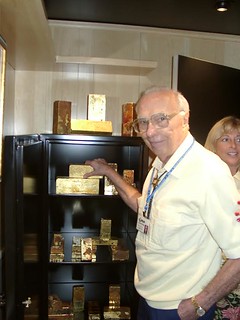 Dave Bowers writes:
Dave Bowers writes:
I am preparing an extensive article on the life of John J. Ford, Jr., and invite anyone with pictures of JJF, New Netherlands office and auction room, or related to send them to me, for possible use (will be credited).
Can anyone help? Here's one photo The E-Sylum has of Ford. It was taken at the 2000 ANA S.S. Central America exhibit (by Dave Bowers!) -Editor
To read the earlier E-Sylum article, see:
NEWMAN PORTAL RELEASES NEWMAN-FORD CORRESPONDENCE (http://www.coinbooks.org/esylum_v19n30a06.html)
Grover Criwsell's Two Dollar Bills
Kevin Flynn's old "counterfeit" $10 bill reminded Bob Leuver of a related story. The former Director of the Bureau of Engraving and Printing and Executive Director
of the American Numismatic Association submitted this in May, 2016.
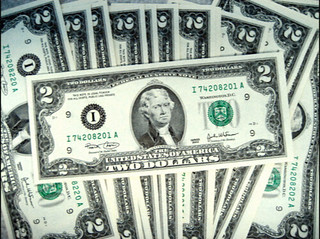 The indomitable Grover Criswell, a man of many numismatic talents and as keen sense of humor, was on a tedious flight from the East coast to the West coast. In need of a
libation to shorten the trip, he asked the flight attendant for a stout spirit drink. To pay, he pulled out a half-sheet of $2 bills, and cut one out to pay for the drink - or did
he tear one off from a checkbook he'd made? Anyway...
The indomitable Grover Criswell, a man of many numismatic talents and as keen sense of humor, was on a tedious flight from the East coast to the West coast. In need of a
libation to shorten the trip, he asked the flight attendant for a stout spirit drink. To pay, he pulled out a half-sheet of $2 bills, and cut one out to pay for the drink - or did
he tear one off from a checkbook he'd made? Anyway...
The flight attendant notified the captain, who called ahead to Los Angeles, the flight's destination. Grover was met by the police and Secret Service when he exited the plane. It took Grover a bit of time, probably in an inconspicuous and dungeon-type room at the airport, to explain he wasn't a counterfeiter, but, rather, THE preeminent, worldwide numismatic scholar and coin dealer--as only Grover could. May Grover rest in peace and the stories of his life brighten any numismatic conversation.
Thanks. I never met Criswell, but he was one of a kind. -Editor
To read the earlier E-Sylum articles, see:
NOTES FROM E-SYLUM READERS: MAY 8, 2016 : Grover Criswell's Two-Dollar Bills
(http://www.coinbooks.org/esylum_v19n19a11.html)
SPENDING AN OLD $10 BILL: GOOD DEED GONE BAD (http://www.coinbooks.org/v21/esylum_v21n43a11.html)
National Coin Hobby Act Enforcement
Yosef Sa'ar of Elat on the Red Sea writes:
Do you have an information on enforcement of the National Coin Hobby Act which required the word COPY on replicas, fakes and other junk? I would be eager to read something about this US regulation. Maybe your readers can help
I haven't heard much lately on if or how this is being enforced today. Can anyone fill us in? Thanks. -Editor
Bikini Coingirl
John Regitko writes:
Re: BIKINI COINGIRL; What were the coins again? I forgot to look at the coins.
Um, wheat cents. I think. -Editor
To read the earlier E-Sylum article, see:
BIKINI COINGIRL (http://www.coinbooks.org/v21/esylum_v21n43a28.html)

THE EMERGENCY MONEY OF LEIDEN
Henk Groenendijk submitted these comments on the emergency money of Leiden. Thank you. -Editor
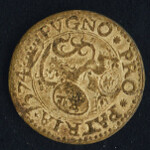

In the October 28, 2018 E-Sylum a 5 Stuiver or ¼ Gulden paper emergency coin from the Dutch city of Leiden is shown. The manufacturing process is described as follows: “shredded prayer books and bibles were made into a macerated pulp and formed into pressed cardboard-like sheets. The sheets were than impressed with dies and either struck in collars or trimmed into perfectly round "coins."â€
This is not correct, a description of this process, together with lots of other information, can be found in “Het Noodgeld van Leiden, waarheid en verdichting†(The emergency money of Leiden, fact and fiction) by Arent Pol and Bouke Jan van der Veen. (ISBN 978-90-12-12452-2). This booklet, based on a study of contemporary documents, is the printed version of a lecture given in 2007 in Leiden commemorating the siege and relief of Leiden in 1574.
In this booklet it is stated that the cardboard sheets were made by bookbinder Jan Adriaensz. by gluing together unused printed sheets. Two types were made, thick cardboard for
the 1 Gulden (20 Stuiver) pieces and a thinner one for the ¼ Gulden. From these glued together pages planchets for coining were cut by stamping. From specimens that have
fallen apart the separate sheets can clearly be seen. An example of such a paper 1 Gulden piece from a recent MPO auction is shown below
(https://mpoauctions.com/nl/bladeren?aid=32&cid=20089&lid=128548)
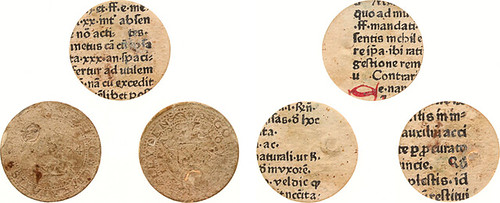
Interesting is that nearly all surviving specimens show a small counterstamp of a lion in an oval of dots. This counterstamp can also be seen on the Newman specimen, near the right leg of the lion. The counterstamp was applied to authenticate genuine pieces. This was needed as already within a few weeks after issue fake specimens appeared.
To read the earlier E-Sylum article, see:
NEWMAN SALE X CURRENCY HIGHLIGHTS : Lot 20014: 1574 Netherlands Siege of Leiden 5 Stuiver
(http://www.coinbooks.org/v21/esylum_v21n43a16.html)
MORE ON RISLEY & MCCOLLUM'S HIPPODROME TOKENS
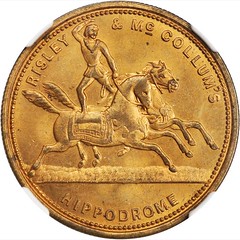
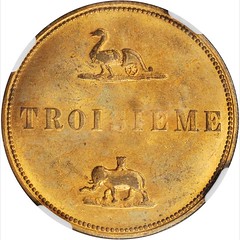
Bob Schuman writes:
In response to your article on the “RISLEY & McCOLLUM†token in the last issue of Ihe E-Sylum, I am the owner of the piece pictured. It was very interesting to read about the history of Thomas McCollum and the circus researched by Margaret Kirby. This type of historical background is one of the joys of collecting tokens.
From the numismatic perspective, I also own the very rare piece with the same obverse but with the reverse inscribed PREMERIE (which I take to be a misspelling of the word PREMIERE). I know of no other specimen, but would love to acquire an example with DEUXIEME on the reverse if one exists. Do any of your readers know of such a piece? Thanks again for producing the most interesting and informative publication in numismatics.
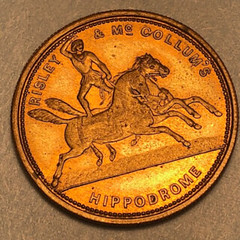
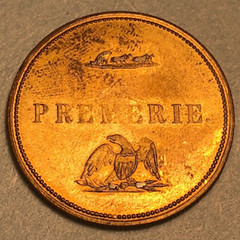
You're welcome, and thanks for sharing your information. -Editor
To read the earlier E-Sylum articles, see:
NUMISMATIC NUGGETS: MAY 21, 2017 : Risley & McCollum's Hippodrome Token
(http://www.coinbooks.org/v20/esylum_v20n21a23.html)
MORE ON RISLEY & MCCOLLUM'S HIPPODROME TOKEN (http://www.coinbooks.org/v21/esylum_v21n43a08.html)
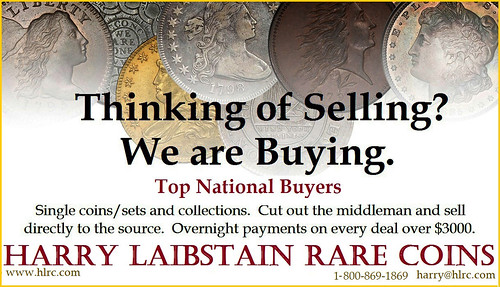
HYDRA IMAGES IN NUMISMATICS
Last week we discussed a German medal featuring a man battling a hydra, and I wondered about other coin or medal designs featuring that mythical multi-headed creature. -Editor
William Todd writes:
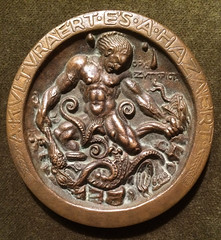 The image of a hero in combat with a hydra is one of the most common of German or Austro-Hungarian images in First World War medallic art.
The image of a hero in combat with a hydra is one of the most common of German or Austro-Hungarian images in First World War medallic art.
I attach an image from my collection of one of the finest - artistically speaking - by a Swiss artist working in Hungary, Richard Adolf Zutt. It’s not an exceptionally rare piece and bronze examples (as opposed to silver) can usually be picked up relatively cheaply.
I also suggest anyone interested in the subject examine a copy of a book reviewed in your pages some months ago: Klose, Dietrich O. A. Europas Verderben 1914 1918: Deutsche und österreichische Medaillen auf den Ersten Weltkrieg. 2016. This book contains a number of excellent examples illustrated in color.
Gary Greenbaum writes:
The medal for the 1801 Battle of Copenhagen issued by the (losing) Danes shows a soldier battling a hydra-like creature.
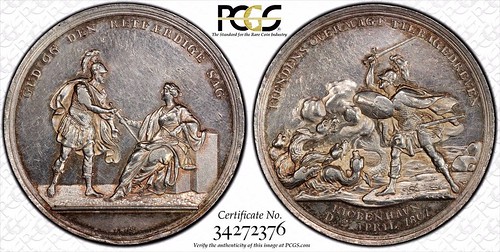
To read the complete item description, see: Medal 1801 World Medals Denmark Christian VII Silver Battle of Copenhagen PCGS AU55 TOP GRADE PCGS AU55 TOP GRADE (https://www.ma-shops.com/enumismat/item.php?id=17395&lang=en)
Ed Hohertz submitted these classical images of the hydra from the auction archives of Classical Numismatic Group. Thanks. -Editor
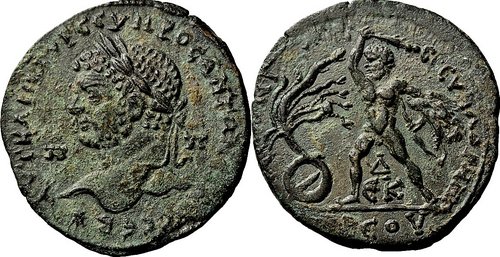
For the complete lot description, see: https://www.cngcoins.com/Coin.aspx?CoinID=206928
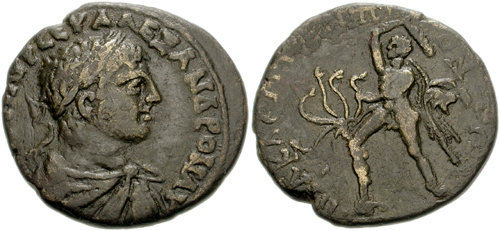
For the complete lot description, see: https://www.cngcoins.com/Coin.aspx?CoinID=73965
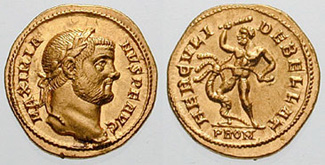
For the complete lot description, see: https://www.cngcoins.com/Coin.aspx?CoinID=16754
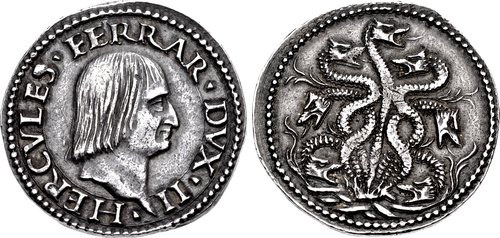
For the complete lot description, see: https://www.cngcoins.com/Coin.aspx?CoinID=318717
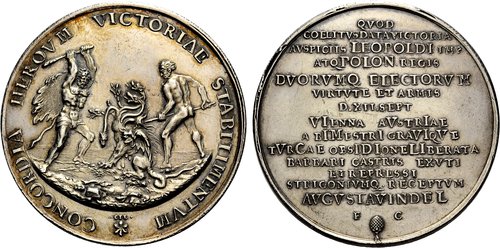
For the complete lot description, see: https://www.cngcoins.com/Coin.aspx?CoinID=195729
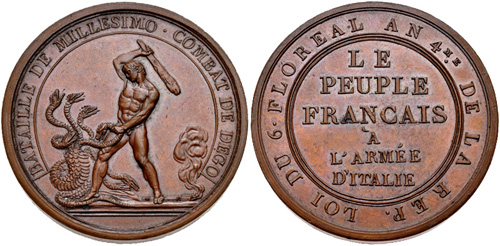
For the complete lot description, see: https://www.cngcoins.com/Coin.aspx?CoinID=311338
To read the earlier E-Sylum article, see:
NUMISMATIC NUGGETS: OCTOBER 28, 2018 : WWI German Medal Man Battles Hydra
(http://www.coinbooks.org/v21/esylum_v21n43a15.html)
VOCABULARY TERMS: BLANKED, BLANKING
Blanked, Blanking The process of cutting out blanks, from metal strips of proper thickness (gauge) prior to striking into coins, medals or other items. The manufacture of blanks is the first step of many metalworking processes by cutting blanks from previous rolled strip stock. The goal of blanking is to provide the correct metal composition in a form suitable for the required press with the blank in the proper shape, weight, diameter and thickness. To these five requirements is often added three others, particularly for coining presses, the proper preparation of the edge, by upsetting; coin blanks are also annealed (to soften them for striking) and metal cleaned (to rid all surface adherents).
Blanking is accomplished with blanking dies in a press (most any kind of metalworking press). It is called cutting-out in England, and the blanking press that accomplishes this a cutting-out press. Americans called it simply cutting – particularly with a single blank – until 1896, when multiple blanking was introduced and the term "blanking" was thereafter applied to all blank production.
History of Blanking. Globular lumps of metal were first used as blanks for the earliest coins. Later, the metal was hammered into thin, flat sheets and cut to approximate shape by hand shears (providing struck pieces with very irregular edges). Attempts were made of casting blanks to be later struck (cast blanks). However, it was Leonardo da Vinci, and later goldsmiths, who developed a rolling mill to create flat plates from which blanks could be cut. Da Vinci also made a drawing of a crude blanking punch (see illustration). It is doubtful it was ever used, as the blanks had to be ejected through a opening in the punch.
Da Vinci also drew plans for a blanking press based upon the concept of a drop hammer. A manual wheel pulled a weight on a cord to the top of the press; when released it dropped on a spring blanker. The blanking dies cut out the circular blank from metal strip. The spring caused the blanking die to retract separating it from the metal strip (stripper). There is no record that da Vinci's press was ever built (or would have worked in the 16th century). However, in the 20th century the International Business Machine Company financed the construction of a full scale model from da Vinci's drawings. (This model is now in the Smithsonian Institution, Washington).
Leonardo da Vinci envisaged several important blanking technologies: using strip stock, employing a blanking die and stripping the skeleton strip from the blanker. (Da Vinci's drawing also indicated a duality in his concept – blanking was done on one side, embossing on the other with a blanking press coupled to a striking press. In theory, he reasoned correctly, a blank had to be created before a piece could be struck. Perhaps he intended that with a single impact from the drop hammer, that a piece could be struck and a blank for the next striking be formed at the same time.)
Before, and long after da Vinci's time, coin blanks were cut out with shears from hammered flat plates. They were then trimmed to approximate circular shape by grouping together a handful in a stack and filing their edges. This repetitious work was all done by hand. It was only then they could be struck by moneyers.
As a substitute, or when round blanks could not be made, coins were often struck on square or lozenge-shaped blanks, called klippe. These were easy to cut with shears. If even this could not be done, blanks were cut in a closely circular shape, resulting in mis-shaped coins. At Spanish-American mints with no blanking equipment (Mexico City, 1535-1732, Lima and Potosi until 1767) the coins struck from these oddly shaped blanks and are called cob money.
The first blanking press for making coin blanks was developed by Max Schwab in Augsburg, Germany in 1550. He developed the blanking press – along with a rolling mill – to accompany the screw press he had improved upon. He tried, unsuccessfully, to sell these to the Vienna Mint, but it was the French ambassador who learned of his innovations and ordered these for the Paris Mint.
A mintworker from the Lyons mint, Aubin Olivier, was instructed to go to Augsburg, learn the operation of these machines and transport them to Paris. He arrived at the Paris Mint 31 January 1551 with a rolling mill, draw plates, a blanking press and one of Schwab's improved screw presses. Placed in use immediately, blanking was done from stock drawn and rolled on Schwab's equipment. Quantity blanking was in production there by Antoine Brulier for coins struck in early 1552.
The first known supplier of blanks to coinage mints was Avesta, a Swedish mint near a large copper mine ("copper mountain") in central Sweden. In 1672 Avesta supplied copper blanks to the Royal Mint London for the regal copper coinage of Charles II.
Birmingham metalworking factories, notably the Anglesey Copper Company, as early as 1787 were manufacturing blanks and tokens of fine quality. But it was Matthew Boulton who made tremendous improvements in blank manufacture at his Birmingham factories, and later in his Soho Mint, not only in cutting out perfect circles of correct gauge metal, but also in edge preparation. He did this with the aid of Jean-Pierre Droz, who he had hired away (1789) from the Paris Mint. By 1790 Boulton could blank uniform disks of proper metal in quantity with an upset edge for coining and striking coins, tokens or medals.
Back at the Paris Mint, Droz had left behind his inventive associate Philippe Gengembre. Gengembre was the mint's machinist with whom Droz had worked on a press feeder, one of the innovations that had attracted Boulton. Gengembre continued working to improve the mint's equipment and, by 1797, had succeeded in matching even Boulton's blanking technology.
Subcontracted blanking. Whenever a new mint is established, a steady supply of blanks is usually its greatest problem, solved by most early mint officials by securing blanks from outside sources. Early American mints purchased blanks from Boulton and other English manufacturers. Then the mint obtains its own equipment and expertise to manufacture its own blanks. Recently, the source of blanks has gone full circle; need for special blanks (clad or sandwich, plated, bimetal, or such) that private manufacturers outside of mints are again supplying blanks by contract, leaving mints to do only die preparation and striking.
For mints and medal makers, outside sources for blanks of precious metals are desirable since it precludes any need of salvaging scrap and reprocessing this (with potential scrap loss). Thus a small separate industry exists of supplying custom blanks of prescribed composition with exact diameter, thickness and other characteristics to order for mints and medal manufacturers.
Multiple blanking. It wasn't until the early 20th century that blanking dies of more than one punch were widely used in production blanking for coins. Dual punches were first used in England prior to 1888 (in the U.S. as early as 1896). The Tower Mint was blanking shillings two blanks at a time and as many as five copper coin blanks were cut out with each cycle of the blanking press. This was particularly useful for coins of small diameter (say, under one inch) where great quantities are in constant need to keep presses supplied.
The first person to develop multiple blanking is unknown. It probably originated in Germany; Cooper attributes this important coining development only to a German Dr. May. It was probably used in the metalworking field before it was adapted to coining and spread to all major mints nearly the same decade, before the turn of the 20th century.
Continued improvement in blanking now permits as many as 30 blanks to be created with each press cycle. This requires a wider strip of metal – with an elaborate blanking pattern – and very high quality steel to make the blanking die plate. Multiple blanking tends to reduce slightly the amount of scrap remaining after blanking, with far fewer malformed blanks, in a more efficient operation.
How blanks are made. Blanks are cut from strips that are made from ingots of correct composition;; rolling mills roll the strips to proper thickness (gauge and width (length of the strip is not that important). The strips are then fed into the blanking press. For short runs the strip may be fed by hand. For production blanking the strips are fed continuously for the length of the strip. After the blanks are punched, the leftover strip remains as skeleton scrap, destined to be melted and reprocessed into strips again. (From 30 to 35% remains as scrap in even the best blanking pattern.)
Blanking is accomplished on a blanking press with specially prepared blanking dies. Actually a "die set," blanking dies are formed of three basic parts: (1) a plate into which a hole is cut the exact shape and size of the intended blank, (2) a punch which fits into the opening in the plate, and (3) a stripper which removes the scrap from the punch. A separate punch holder is sometimes required to fasten small punches into the chuck of the blanking press (where changes to different diameters or shapes are required).
The plate and punch are made of hardened steel. The aperture in the plate has a slight flare – the hole widens slightly in the body of the plate – so the blank ejects easily. The plate and punch are positioned (setup) in the blanking press; its action can be described as follows: the punch forces the metal strip (of soft material, as bronze or silver) against the plate and pushes it through the aperture in the plate. This shears or cuts out the blank as the punch continues it's downward motion forcing the blank through the plate (to fall into a hopper or tote box below). As the punch withdraws the stripper forces the skeleton strip free of the punch.
Striations on the edge of the blank are the evidence the blanks have been sheared.
These shear marks are caused by tiny imperfect edge irregularities inside the aperture of the blanking plate. (See illustration.) When the blanking plate is freshly made, there are few striations. As it wears these tiny nicks may appear, and more striations appear on a well- worn blanking plate.
As the punch forces the metal through the aperture in the plate, there is a tiny trail of metal debris on the edge of the blank. This burr is typical of all cutting and shaping in metalworking. Only one side has this burr and it is called the burr side. All burrs must be removed; blanks to be coined are deburred by upsetting. Blanks for striking with open face dies may be struck without removing the burrs first, as these will disappear during multiple striking and trimming.
Blanks are made of any size or shape with close tolerances. coin blanks must be exactly the weight of the intended coin; the upsetting does not remove any metal, but shapes the blank and makes it perfectly round. Then the blank can be fed into a coining press to be struck within collar dies. (Blanks before they are upset are called first process blank by collectors, a second process blank after they are upset.)
Blanks to be struck with open face dies may be made slightly larger than the intended diameter of the final piece; exact size blanks are not a requirement. These some- what oversize blanks, will have a part of their material – flash – removed after they are fully struck up after multiple striking.
Maximizing the number of blanks. During the sequence of blanking, irrespective whether the strip is hand fed under the blanker – or whether the strip is fed automatically –it is desirable to cut the blanks as closely together as possible. This is done to reduce cost by maximizing the number of blanks obtainable from the strip (and also reduce the amount left as skeleton scrap).
This blanking pattern is dramatically shown on the leftover strip and how successful the blanking press operator was to maximizing this number (for hand-fed blanking). The ingenuity of the press operator is even more dramatic for blanks that are irregularly shaped and hand fed: how to blank as many pieces as possible in the quickest time from the long strip of metal.
Cleaning blanks. In most metalworking operations, cleaning the workpieces is a step just prior to any metal forming, as in coining or striking. Removing oil or grease – and other surface debris – is required of this step of cleaning (see degreasing). Because blanks contain no detail yet, they can be severely cleaned by removing the top layer of metal. This removes all toning, tarnish and corrosion. The goal is to provide a surface which can be formed without any imperfections which the above surface contaminants may cause.
Blanks are cleaned by any of several methods: blanching, abrasive blasting, shot peening, acid dip (pickeling), heat treating, water hone (remeoving unwanted metal with a whetstone) . But the most popular in coin and medal production is barrel tumbling. Blanks are placed in a large drum along with sawdust, ball bearings, shot or other metal particles and the barrel is set to rotating.
The tumbling action causes all these objects to knock against each other. This removes toning, tarnish and corrosion by lightly removing the top surface. Afterwards the aggregate is removed and the blanks are separated (by screening). At this stage the blanks will have an activated surface, which, depending upon the environment, will start natural toning in from two days to six months.
Blanking anomalies. A broad spectrum of errors can occur in blanking. For the most part the most common is a clipped blank where the full circle of metal is not cut out as desired (the strip is not advanced far enough and the punch "clips" a part of a previous hole). double clip and multiple clip, as well as straight edge clip can also occur.
An incomplete punch shows the partial impression in metal that is later blanked and struck. A saddle strike is a modern error from the use of dual dies. Struck fragment is the aberrant use of a fragment of metal instead of a full blank. A very rare blanking anomaly is out-of-round blanks.
Too large a planchet is called a broad flan if this is noticed and the blank is reduced in size, it is a cut-down blank. An incorrectly chosen blank is wrong planchet. While a dumb blank contains gas pockets so it does not ring properly, it is a result of incorrect milling and rolling. [Other blanking errors occur, particularly in coining, see section 06.9 in the Study Guide Outline.]
Future of blanking. While new alloys, clad or sandwich metal compositions – bimetal and trimetal compositions – do not present blanking problems (if the composition can be rolled flat to a prescribed gauge), perhaps in the future we will see computer-controlled laser cutters that will provide blanks of any shape or size – particularly for unusual shape medals – to very close tolerances and maximize the number of blanks per given strip. Or, perhaps, blanks will be formed to any shape or size by high density molding. But for the present, as it has for the last 450 years, cutting out blanks of required size from strip metal stock remains the most satisfactory method of obtaining blanks for creating struck coins and medals.
References:
C43 {1966} Gilbert, blanking presses, #25, 27, pp 21.
C66 {1988} Cooper [ancient blanks] pp 10-12; [early blanking] 97-101; [modern] Chapter 17, 187-199.
Looking for the meaning of a numismatic word, or the description of a term? Try the Newman Numismatic Portal's Numismatic Dictionary at: https://nnp.wustl.edu/library/dictionary
Or if you would like a printed copy of the complete Encyclopedia, it is available. There are 1,854 terms, on 678 pages, in The Encyclopedia of Coin and Medal Technology. Even running two a week would require more than 19 years to publish them all. If you would like an advance draft of this vital reference work it may be obtained from the author for your check of $50 sent postpaid. Dick Johnson, 139 Thompson Drive, Torrington, CT 06790.

JAMES GALEN (1840-1906)
 James Galen was an early numismatic and philatelic publisher with a magazine beginning during the nation's Centennial Celebration in 1876. He was an avid coin and
stamp collector as well as a collector of curiosities of all sorts especially natural history, and plant species in particular. Unfortunately, he is unknown in the coin and stamp
communities since he was a contributor to these fields, but has fame as a botanist. He never married and lived with his mother until her death in 1896.
James Galen was an early numismatic and philatelic publisher with a magazine beginning during the nation's Centennial Celebration in 1876. He was an avid coin and
stamp collector as well as a collector of curiosities of all sorts especially natural history, and plant species in particular. Unfortunately, he is unknown in the coin and stamp
communities since he was a contributor to these fields, but has fame as a botanist. He never married and lived with his mother until her death in 1896.
He served during the Civil War in 1863.
James Galen (1840-1906),was born on March 23, 1840, son of Edward Galen (1811-1873), and Nancy Armstrong Galen (1818-1896). The family lived in Martic Township, Lancaster County, Pennsylvania. He lost the election as town assessor in 1881.
Galen published The Philomath, a semi-monthly journal devoted to the collecting of coins, stamps. etc., printed at Rawlinsville, Pennsylvania, from 1876 to 1877, comprising four 5" x 8". At. least fifteen numbers were issued.
James Galen was reported to own the largest numismatic cabinet in Lancaster County in 1883.
He was a botanist and published on local flora : Galen's First Annual Catalogue of North American Herbaceous Plants, Orchids, Shrubs, Climbers, Alpine, Aquatic, and Bog Plants, Rare Ferns, Etc: For 1882; and Galen's Flora of Lancaster County, Penna., (1884)
He also published in 1884 A Catalogue of Books, Catalogues and Circulars.
In 1892, he moved to Bethesda, Pennsylvania.
He died of paralysis on November 29, 1906. He is buried at the Rawlinsville Methodist Cemetery, Lancaster County, Pennsylvania.
John Lupia adds:
I cannot find much on his coin activity, collection, and what happened to his very large coin cabinet filled with coins from antiquity to U. S. series. I think he has been a very overlooked person and deserves a more prominent position since he published a journal The Philomath, for collectors of coins, stamps, natural history, etc. He is certainly someone readers of The E-Sylum, especially the bibliophiles should get to know and hunt down his collecting magazine.
Indeed. For someone purported to have the largest cabinet in the country he's a ghost today. Many numismatists of the era like Galen also collected stamps, Indian relics, bird's eggs and the like. But what became of his coins? -Editor
To read the complete article, see:
GALEN, JAMES
(https://sites.google.com/a/numismaticmall.com/www/numismaticmall-com/galen-james)
The entire inventory of the Lupia Numismatic Library is for sale. Individual items will be available before the remaining archives are broken up into parcels sold at philatelic auctions in the U. S. and Hong Kong. Check NumismaticMall.com frequently as dozens of new items with estimates will be posted daily until everything is sold.
All inquiries will be given prompt and courteous attention. Write to: john@numismaticmall.com .
DENNIS TUCKER REMEMBERS J.T. STANTON
In an October 29, 2018 Mint News Blog article, Dennis Tucker remembers J.T. Stanton. With permission, we're republishing it here. -Editor
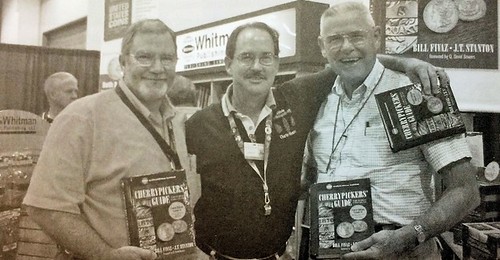
Cherrypickers’ Guide at the American Numismatic Association’s
summer 2006 World’s Fair of Money in Denver, Colorado.
J.T. Stanton, one-half of the creative team (along with coauthor Bill Fivaz) behind the Cherrypickers’ Guide to Rare Die Varieties of United States Coins, died October 19, 2018, following a brief illness, at the age of 66. He was surrounded by his family at the time of his passing.
If you asked J.T. what his initials stood for, he would reply, “Just Terrific!†(Actually, it’s Jeffery Thomas.) He was born in Macon, in the heart of Georgia, about 85 miles south of Atlanta. J.T.’s career was in retail management and printing, but the hobby community knew him best as a professional numismatist and educator who helped popularize “cherrypickingâ€â€”the art and science of closely examining what appear to be normal coins, looking for doubled dates and other die anomalies that reveal them to be rare and valuable varieties.
J.T. and Bill debuted the first edition of the Cherrypickers’ Guide at the January 1990 Florida United Numismatists show in Tampa. They sold out the 500 copies they brought to the show and gathered a backlog of orders to be mailed. The first print run of 3,000 books sold out in less than 10 months. Word-of-mouth publicity and excitement in the numismatic press convinced the authors to create a second edition, with more listings, the addition of retail values, and other improvements. It took collectors about six months to snap up the second edition’s print run of 5,000 books.
The third edition featured about five times as many varieties as the first. It went into six printings totaling more than 28,000 copies—a best-seller in the antiques and collectibles market.
By the fourth edition the Cherrypickers’ Guide was so large it had to be divided into two volumes. Volume I covered half cents through nickels. Whitman Publishing acquired rights to the book and published volume II, with half dimes through silver dollars, gold, and commemoratives, in 2006.
I first met J.T. Stanton in December 2005, in Atlanta, after Whitman bought the Cherrypickers’ Guide. He was 15 years into his journey as one of the most famous popular names in the hobby—but he was as humble, down-to-earth, and good-natured as anyone I’ve met. He insisted that we put him up at “the cheapest hotel you can find,†and not make a fuss. We had breakfast at the local waffle place.
J.T. was always forward-thinking, upbeat, and optimistic. He cared deeply about the hobby and coin collectors. “Above all,†he and Bill have written in the Cherrypickers’ Guide, “always use courtesy and respect in all your dealings, be honest, and always act in a professional manner. You’ll make some friends along the way, and we guarantee you’ll come out ahead in the long run.â€
Over time I would learn some of Bill Fivaz’s “J.T. stories.†In the mid-1990s, the two of them flew out to Colorado Springs to teach a class at the American Numismatic Association’s Summer Seminar. When they unpacked their suitcases, Bill realized he’d forgotten to pack his undershorts. J.T. kindly drove his friend to the local K-Mart to restock. Later in the week, Bill was auctioneer at the Young Numismatists benefit auction. He ballyhooed a “Mystery Lot†that saw spirited bidding and finally sold for $400. J.T. insisted that Bill open the Mystery Lot in front of the audience. Turns out it was a pair of his “tighty-whiteysâ€â€”J.T. had purloined them after they arrived at their dorm, had everyone at the ANA Summer Seminar autograph them, and put them up for bid as a prank. “That pair of underwear appeared in at least three more YN auctions over the years,†Bill recalled, “and in the last one, they’d been ‘slabbed’ between two pieces of plastic. Thanks, J.T.!â€
The last time I talked with J.T. was a few months ago when we had several conversations about coins and life in general. He and his wife of 38 years, Susan, had recently moved from their longtime home city of Savannah to Townsend, Georgia, about an hour south and slightly inland. “I love it here,†he told me. “I feed the deer twice each day, and the freshwater lake is 75 feet from my back door. Every day Susan and I are down here we enjoy it more and more.†He talked about having privacy but also the advantages of a community. “And I’ve always loved nature,†he said, “so this really is a slice of Heaven.â€
Our last acts of collaboration as publisher and author/researcher illustrate J.T.’s generosity to the hobby. When I told him Whitman needed some photographs of modern Lincoln cents, Roosevelt dimes, and Washington quarters, he threw open his entire image library of coins. He said if there was anything he hadn’t photographed yet, to just let him know. And if one of the large groups of photos weren’t in the style or format we needed, he could reshoot everything in three weeks.
When J.T. passed away, he had been happily selling coins on eBay (with more than 17,000 positive transactions), was still very active in discussion and analysis of die varieties, and had pitched a new book idea in recent years. Just a few days before he passed, I was telling several others on the Whitman staff about J.T.’s generosity in sharing his excellent high-quality photographs. His death took us all by surprise. Bill Fivaz attended his funeral, which was held at Radiant Life Christian Fellowship in Savannah on Monday, October 22, with his cousin, The Reverend David Stanton, presiding. Other numismatists at the service included Kyle Vick, Tony Mesaros, Bob O’Brien, and Jim O’Bryant.
J.T. is survived by his wife, Susan; sons Jamie (Meredith) and Jeffery (Liz); grandchildren Henry, Thomas, and Katie; sister Barbara (Kirk); and “many dear cousins and his loyal dog Kobe.â€
“He had a deep appreciation for the military and never passed up an opportunity to thank a member of the Armed Forces for their service,†his family noted. They suggest that remembrances be made to the Wounded Warrior Project, PO Box 758517, Topeka Kansas 66675-8517.
To read the complete article, see:
A great educator and ambassador: The hobby community marks
the passing of J.T. Stanton (http://mintnewsblog.com/a-great-educator-and-ambassador-the-hobby-community-marks-the-passing-of-j-t-stanton/)
To read the earlier E-Sylum articles, see:
J.T. STANTON (1952-2018) (http://www.coinbooks.org/v21/esylum_v21n42a16.html)
NOTES ON THE DEARLY DEPARTED (http://www.coinbooks.org/v21/esylum_v21n43a06.html)

HARVEY STACK'S NUMISMATIC FAMILY, PART30
Harvey Stack's blog series focuses on growing up in a numismatic family. Here is part 30. Nothing beats a report on numismatic events and personalities direct from someone who was there to witness them in person. Thanks, Harvey! -Editor
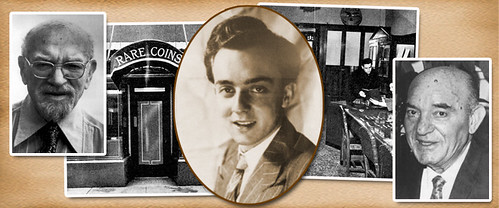
As with everything in the world, nothing remains the same. The coin business grew quite successfully in the decade of the 1950s as more collectors entered the field after World War II. People had more time and money to devote to their hobbies and build and maintain their collections. While things like television created a distraction taking time away from studying coins, those who had developed the collecting spirit continued to be attracted by building and completing collections.
At the U.S. Mint, the 1950s saw Proof set mintages grow from about 50,000 to over three million sets. Speculation in such sets and Mint State rolls as a store of value had peaked and by the beginning of the 1960s the growth bubble had started to burst as the supply kept growing.
The Treasury's new law to try and stop counterfeits from entering the country, mandated that all gold coins entering the U.S. must be licensed and examined. The Office of Gold and Silver Operations had to set up criteria as to what could be imported and what would not receive licensing. Imported gold coins had become a great source for building collections, and even among United States issues, there were many opportunities to purchase from overseas. Especially among $20 double eagles, quantities had been found in vaults where they had been hidden by the Axis powers. Many such coins had been sent overseas before World War II to pay United States debts and the value of such coins had risen above face value. But, importing United States coins was subject to the same regulations that had been put on all gold coin imports, making getting these coins to the United States more difficult and less desirable.
The new regulations said that no license would be issued for any coin dated after 1933, an attempt to adhere to the Gold Act of 1933-4. The Treasury established a guideline for importing, in accordance with criteria that they created and did not reveal these rules to the importers or to the public. Because of this those who wanted to buy overseas never knew what would or would not be licensed. It became difficult to access important sources of coins from overseas.
Old time collectors who had maintained their collections after the 1933-4 law, became afraid that the Treasury's policy of permitting gold collections would change and they might seize all gold coins in America. The 1930s gold law specifically exempted collector items made before 1933, but some numismatists still worried and some were discouraged from collecting until policies were clearer. Some even worried about putting their collections up for sale or auction. Collecting slowed down and many stopped buying for the time being.
The market seemed to almost stop dead for part of the year of 1961.
Stack's still received consignments, and had two major sales in 1961. The Howard Egolf Collection had been started by the consignor's father, with some of the series completed by the son. As he was getting older, the consignor was ready to see it sold. In addition, we were able to offer a world gold coin collection that had been built over many years. The collector wished to sell the collection while he was still alive, rather than leave it to be dealt with as part of his estate.
What was a great help to us, was that we were able to buy foreign gold coins that were already in the United States from dealers and collectors nationwide and sell them to J.K. Lilly as he expanded his collection. And Mr. Lilly was able to acquire some very nice and rare coins at favorable prices, because some collectors had concerns about ownership in the current market.
As 1961 came to an end, things began to turn around. A better understanding of the new import regulations led to a feeling of optimism as 1962 opened, and gave hope for a revival of interest in coins.
To read the complete article, see:
Harvey Stack Remembers: Growing up in a Numismatic Family, Part 30 October 30, 2018
(http://www.stacksbowers.com/News/Pages/Blogs.aspx?ArticleID=3157)
To read the earlier E-Sylum article, see:
HARVEY STACK'S NUMISMATIC FAMILY, PARTS 28-29 (http://www.coinbooks.org/v21/esylum_v21n42a27.html)
BALDWIN HORSEMAN $10 STRUCK ON LARGE CENT
David McCarthy of Kagin's penned a nice article for CoinWeek on an interesting pioneer gold design overstruck on a large cent - the "Baldwin Horseman" $10. Here are a couple paragraphs of a lengthy piece - be sure to read the complete article online. -Editor
 As luck would have it, a package of these coins arrived at my office while the discussion was going on, and alongside the “restrikes†there was something a little more
interesting: an 1844 large cent overstruck with dies for a Horseman $10. This Horseman $10 wasn’t one of the imitation pieces, but it wasn’t a Baldwin $10 either. When
I saw it, the first thing I thought was, Holy shit, that’s rare!
As luck would have it, a package of these coins arrived at my office while the discussion was going on, and alongside the “restrikes†there was something a little more
interesting: an 1844 large cent overstruck with dies for a Horseman $10. This Horseman $10 wasn’t one of the imitation pieces, but it wasn’t a Baldwin $10 either. When
I saw it, the first thing I thought was, Holy shit, that’s rare!
The coin’s 1850-dated obverse bore the familiar Horseman motif: probably the best-loved image on any coin of the California (or any other) gold rush. The reverse was different from the famous Baldwin $10: it was inscribed “KOHLER & Co. SAN FRANCISCO†around a small eagle and 31 stars, an apparent reference to California’s impending status as the 31st U.S. state. Known by a small handful of numismatists since the 19th century, the Kohler $10 pattern was still quite mysterious: the only published picture of the piece had been taken nearly 70 years ago, making it impossible to determine whether it was a clever fantasy or an important piece of California history.
To read the complete article, see:
Holy Sh*t, That’s Rare: A Horseman $10 of a Different
Color (https://coinweek.com/dealers-companies/kagins/holy-sht-thats-rare-a-horseman-10-of-a-different-color/)

JOHN PINCHES TWO-HEADED MORGAN DOLLARS
Web site reader Tree Sturman asked about "a two-headed nickel copper Morgan Dollar coin dated 1879." His piece turned out to be a trick coin, but there do exist "real" examples - not from the U.S. Mint, but from John Pinches Ltd. in England. Here's a Numismatic News fun fact published August 13, 2018. -Editor
Is it true there are unofficial two-headed strikes of the 1879 Morgan silver dollar?
Unofficial is almost an understatement. John Pinches Ltd. in England produced transfer die two-headed 1879 silver dollars in copper and copper-nickel in an ill-fated effort to obtain a contract to strike U.S. coins commercially. Several examples later entered the coin collecting market through the 1947 auction of the John Harvey Pinches estate.
To read the complete article, see:
Reopened ‘O’ Mint made proof dollars
(http://www.numismaticnews.net/article/reopened-o-mint-made-proof-dollars)
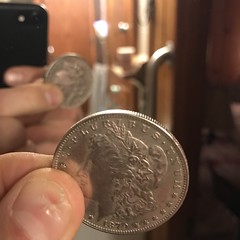
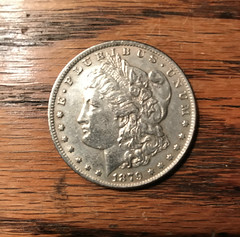
Above are images of Tree's coin. Here's more from Dave Bowers' silver dollar encyclopedia. -Editor
Two-Headed 1879 Morgan Dollars
In or around the year 1879 the firm of John Pinches, Ltd., of England, desired to obtain a contract to strike United States coins on a commercial basis. Sample 1879-dated Morgan dollars were made up, consisting of two-headed coins. Apparently, Pinches had a very advanced technology for making transfer dies from existing coins, for the few known specimens struck from these dies are all very well struck and for all intents and purposes are as fine as the Philadelphia product. Strikings exist in copper and copper-nickel metals.
Glendining's London Sale of the John Harvey Pinches estate, July 29, 1947 offered examples. Also see Stanislaw Herstal Sale (Bowers and Ruddy); Glendining Sale of Nov ember 18, 1987, Lot 109; Superior's Auction '88, Lot 237. The 1987 Glendining Sale offered two obverse dies and other items fitted into a case. (Information courtesy of Michael]. Hodder.)
So - does anyone have images of these? Where are they today? Interesting item. -Editor
To read the complete article, see:
Silver Dollars & Trade Dollars of the United States - A Complete Encyclopedia
(https://www.pcgs.com/books/silver-dollars/Chapter15Listings-023.aspx)

ON THE MINT'S MANUFACTURED RARITIES
Reader Vic Mason of Mamaroneck, NY submitted these thoughts on the Mint's plan to purposely manufacture rarities for circulation. Thanks! -Editor
Many thanks for forwarding Patrick Heller’s excellent summary of the proceedings of the United States Mint’s Third Annual Forum on October 17th.
The new director of the United States Mint, Mr. David Ryder, has generated considerable excitement in the hobby by proposing to issue a rare circulating coin in 2019, without specifying what it might be. But serious doubts have arisen about the feasibility of the proposal, as expressed by Coin World Editor Bill Gibbs and two CW letter-writers in that publication’s latest digital edition. They worry that most coins in the rarity-release program will end up in the hands of big dealers gaming the system rather than of “the little guys†who have always loved the hobby but think that now the coin distribution system at the Mint is rigged against them.
But Mr. Ryder’s proposal is about making business-strike coins intended for immediate release into the mass of circulating coinage. It’s not about announced, timed-release uncirculated, proof, commemorative or bullion products. The good thing about Mr. Ryder’s proposal is that it recognizes that the romance and beauty of coin collecting that got most of us hooked early on have always centered on unexpected discoveries in pocket change. It was the thrill of the hunt. That’s how most of us grew up as little kids, searching passionately for scarce and rare coins already in circulation.
In the early 1950s in Detroit, for example, I could find oodles of Lincoln wheat cents, Liberty Head and Buffalo nickels, Mercury dimes, Standing Liberty quarters, Walking Liberty and Franklin halves, many Barber dimes, quarters and halves, and even 19th and early 20th century Canadian copper, nickel and silver coins (then valued at parity with American coins) in circulation. In those days, it was not uncommon to find coins with greater than face value, as based on the prices published in the Blue Book and the Red Book. That likelihood quickly fell, 40 or 50 years ago, as production numbers for coins of all denominations soared and especially after all silver coinage disappeared in the mid-1960s.
Now many see the hobby and the industry at a crossroads. Rick Amos, CEO of Amos Media – in a panel discussion (entitled: “Coin World: Open Forum Discussion on Our Hobby Moving Forwardâ€) at the World’s Fair of Money of the American Numismatic Association last August in Philadelphia – quoted a dealer who said, “In ten years, 70 per cent of those dealers (in the bourse upstairs) won’t be there.†The implication was that, as the hobby and the industry keep “graying,†those dealers won’t be replaced. Others have written recently about the steady decline in the ANA’s membership, in coin shops around the country and in coin clubs in many areas.
I noted in my CW Guest Editorial this week that it’s too bad the Mint did not think last year about making between 500,000 and one million Lincoln cents in Philadelphia without the P mint mark. The Mint, thinking bureaucratically, assumed collectors would be excited by the novel manufacture of over four billion 2017 pennies at the Philadelphia Mint with the P mint mark for the first time ever. Had the Philadelphia Mint deliberately dropped the P from a few dies, sharp-eyed collectors nationwide would soon have thrown the coin-collecting community and the country into “a frenzy†of searching for the “rarities,†which would likely have generated three- and perhaps even four-figure premiums in dealer auctions or on eBay.
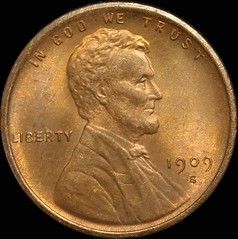 In 2017, the Mint made 8.634 billion pennies for circulation, roughly half each at the Philadelphia and Denver Mints. One million cents minted last year without the P or
D mint mark would have constituted less than one in every 8600 coins produced – for collectors, perhaps akin to looking for a needle in a haystack, but a lot better odds than
winning the recent Power Ball lottery. If 500,000 had been produced, the odds would have been one in around 17,000 pennies made last year. (Remember that the mintage of the iconic
1909-S VBD Lincoln cent was 484,000.) And this year, the Philadelphia Mint could have done the opposite, producing half a million to a million pennies with the P mint mark hiding
in the coinage. Over the past 18 months, up to two million American kids could have been happily searching their families’ change, notifying coin publications of their
finds, showing the coins to classmates and to coin club members, and reluctantly putting up their coins for auction to earn money for holiday season gift-buying.
In 2017, the Mint made 8.634 billion pennies for circulation, roughly half each at the Philadelphia and Denver Mints. One million cents minted last year without the P or
D mint mark would have constituted less than one in every 8600 coins produced – for collectors, perhaps akin to looking for a needle in a haystack, but a lot better odds than
winning the recent Power Ball lottery. If 500,000 had been produced, the odds would have been one in around 17,000 pennies made last year. (Remember that the mintage of the iconic
1909-S VBD Lincoln cent was 484,000.) And this year, the Philadelphia Mint could have done the opposite, producing half a million to a million pennies with the P mint mark hiding
in the coinage. Over the past 18 months, up to two million American kids could have been happily searching their families’ change, notifying coin publications of their
finds, showing the coins to classmates and to coin club members, and reluctantly putting up their coins for auction to earn money for holiday season gift-buying.
But how to get from here to there? I suggest in my CW Guest Editorial this week that the main stakeholders (as the Europeans would call them) in the American numismatic community take the lead in forming a public-private partnership (PPP) to help the United States Congress – which a century ago gave the ANA a very special charter to encourage coin collecting in American society – and the US Department of the Treasury, which oversees the Mint, with good “bottom-up†suggestions for new approaches to imaginatively designing, producing and distributing the planned scarce and rare coins for circulation. Included among those stakeholders must certainly be: (1) the Treasury Department, led by the Mint; (2) the ANA, led by the Professional Numismatists’ Guild (PNG), to ensure the highest standards of ethics, integrity and probity in the overall running and oversight of the program; (3) the leading third-party authenticating and grading services: PCGS, NGC, and ANACS, whose operational by- word must always be trust; and (4) the numismatic publishing community, led by The Numismatist, Coin World and their leading counterparts.
Patrick Heller wrote in his valuable summary in last week’s E-Sylum that, at the Third Annual Forum of the Mint in Washington, DC, on October 17th : “Going forward, Ryder said that Mint staff would become more proactive at helping to write [coin-production] legislation so as to incorporate ideas that would be of higher appeal to coin collectors.†This is crucial. So is the necessity of keeping the program transparently honest. Four years ago, we saw how easily the program to produce and issue the US Federal Marshals Service commemorative coins was tarnished, when top leaders at that agency were revealed in late 2014 to have received early releases of the sets produced to honor the history of that service – but dated 2015, the Congressionally-mandated year of issue! The recipients were forced to return those coins to the Mint. [And much of the controversial news about that agency since then has suggested widespread improprieties in its leadership, both at the Washington, DC, headquarters and around the country (which anyone can see by googling references to that agency).]
I believe the Federal Government, aided by the PPP-led commission created to help administer and regulate this special program, can run the rare-coins program as efficiently as the 50 states run their lotteries, even given the much greater complexity of this rare-coin proposal. The 50 states learned years ago from the Massachusetts lottery how easily insiders can undermine trust in a government system. (The same person won that state’s lottery twice within a relatively short time. He hasn’t won since.)
I suggest in my CW Guest Editorial that it is essential that the coins of any new circulating rarity be thoroughly mixed into the general population of coins at a central gathering place in a completely anonymous, random fashion. In that way, the odds of two of the coins ending up in the same roll would be infinitely small. And the commission would need to ensure that the bagged or rolled coins have a demonstrably equal statistical chance of ending up in banks in every region of the country and in small- town as well as large-city banks nationwide.
The Mint should never announce what the forthcoming rarity, or rarities, are in advance, or how many it plans to produce of each. Let sharp-eyed collectors discover them from their unexpected finds in circulation. That would produce a veritable flood of interesting articles and announcements in the numismatic press all year round. I would expect to see a revival of coin shops and clubs nationwide. (The same approach can be taken with all denominations of coinage involved in this program: cents, nickels, dimes, quarters, halves and dollars.)
Once the rarities in circulation start to be identified by collectors, the usual suspects (as in China) will hurry to counterfeit them, so I hope that the PPP’s commission will anticipate that problem with innovative design features aimed at thwarting the crooks. One example is to create alloys with microscopic trace levels of secret ingredients that only the US Treasury’s metallurgists would know about. That, of course, would make the job of the third-party grading services a bit more difficult than in the past in determining the authenticity of submitted coins – but, I think, essential.
Multiple varieties could be produced with any and all the coinage, as we saw with the 2004-D Washington [Wisconsin] “illegal†extra-leaf quarters and the year-2000 Sacagawea “legal†dollar coins with the enhanced eagle tail feathers and with the “wounded eagles.†And there needn’t be just two varieties. Variations in design could also be carried out on the paper bills. And why not with the postage stamps, to help revive stamp collecting?)
Finally, one of my principal motivations in advancing these ideas in support of Mr. Ryder’s proposal is to buttress the value of that huge inventory of common, less-common, scarce and rare US coins “out there†languishing from lack of demand (due to lack of buyers and interest among the American people). Without that interest in common coinage types going back to the founding of the republic, demand for many valuable, hard-to-find key dates is falling. (I know; I closely watch the price tables as on the valuable PCGS Coin Facts web site.) Coin collecting in this country is a wonderful activity. But most of the country’s citizens don’t know that. If they can get kids and their parents back into their shops, dealers should show them all the different denominations (and varieties) of coins that have been produced by this country – and give away or sell very cheaply raw coins, including “problem coins†(with disclaimers in writing and with clear explanations about the implications of re-selling), to help them fill up blue books or their equivalents. Make them knowledgeable because they are showing interest, in the same way that coin collecting apparently first really took off in the mid-19th century. It took off because people inexpensively wanted one example of everything, preferably coming from pocket change -- not expensively buying rarities at auctions or putting together costly registry sets. Let’s remember where the romance of coin collecting came from and where it needs to return to thrive: in the hearts of little kids.
I agree that the magic of the proposal is in relatively rare business-strike coins released to circulation. The 50 State Quarter Series was a great boon to collecting in this country, but it checked only two of those boxes - the coins are not rare, and after the initial public frenzy, premiums over face evaporated. A coin of 1909-S VDB rarity (common in absolute terms at nearly half a million, but rare in relation to its peers) would far more likely develop and retain a premium.
The devil is always in the details of implementation. Where in the supply chain would the coins be introduced? If mixed into bins at the Mints there could be multiple points where "the big boys" could purchase supplies in bulk and find the coins before the public does; there would also be no guarantee of even nationwide geographical distribution, as the majority would naturally flow to population centers due to the needs of daily commerce; and in a recession the coins could pile up in warehouses until needed again.
At the other end of the supply pipeline are bank branches and retail establishments. A "coin drop" style program could ensure wide distribution but requires an army of foot soldiers, each one of whom could succumb to the temptation of palming a few rarities.
So what's the answer? Perhaps a trusted team within the Federal Reserve could insert the coins into the commerce stream in each of the twelve districts. But regardless of the implementation plan chosen, I think it's a concept well worth trying. -Editor
To read the earlier E-Sylum article, see:
2018 U.S MINT FORUM REPORTS (http://www.coinbooks.org/v21/esylum_v21n43a12.html)
ROYAL AUSTRALIAN MINT LAUNCHES TREASURE HUNT
Our friends Down Under are already on board with the concept of a circulating coinage treasure hunt. -Editor
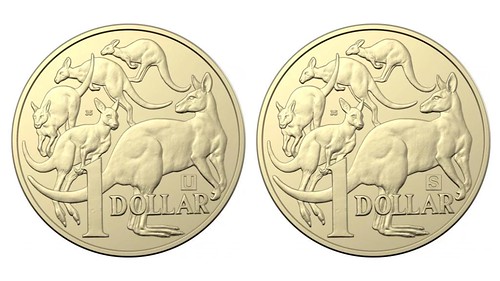
Check your wallets, folks: the Royal Australian Mint has launched a national treasure hunt.
The mint has released 3 million specially marked $1 coins into circulation and people are being urged to check their change.
The coins are marked with the letters A, U or S, are date stamped 2019 and have the number 35 to mark the 35th anniversary of the $1 coin (which is on May 14, 2019).
People who collect one of each coin can enter the competition for the chance to be one of eight to win a trip to Canberra with a stay at the Jamala Wildlife Lodge.
The eight winners - picked from each state and territory - will also get the opportunity to mint their own one-kilogram pure silver coin and receive a VIP tour of the mint.
Royal Australian Mint chief executive Ross MacDiarmid said the golden ticket-style competition was launched to encourage children to collect coins.
"Australia’s Dollar Discovery is a nationwide treasure hunt that we hope encourages Australians of all ages and from every state and territory to check their change for these special coins,†Mr MacDiarmid said.
The five kangaroos design was created by Stuart Devlin, and hundreds of millions of the $1 coins have been minted since 1984.
What a fun idea! It will be interesting to see the news coverage of the results. The competition closes April 8, 2019, and the winners will be drawn on May 14, 2019. -Editor
To read the complete article, see:
Royal Australian Mint launches
a Willy Wonka-style treasure hunt (https://www.smh.com.au/business/banking-and-
finance/
royal-australian-mint-launches-a-willy-wonka-style-treasure
-hunt-20181102-p50dix.html)

NOVEMBER 2018 MEDAL SELECTIONS FROM NUMISMAGRAM
Jeremy Bostwick at Numismagram passed along some interesting pieces from the most recent upload of material to his site. In addition to the items below, there is a particular focus on figural art medals and historical medals relating to World War I---timely in that November marks the 100th anniversary of the end of 'the war to end all wars.' Visit numismagram.com/inventory/ to view all of them. -Editor
Big Bertha Medal
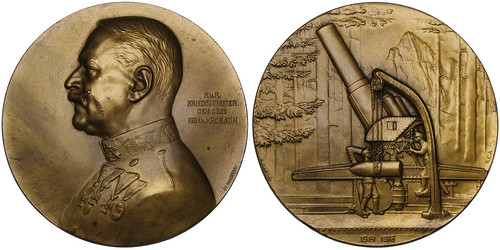
100421 | AUSTRIA-HUNGARY. Alexander Freiherr von Krobatin bronze Medal. Issued 1916. World War I series (65mm, 108.85 g, 12h). By A. Hartig.
K. u. K. KRIEGSMINISTER GEN. OBST. FRH. v. KROBATIN, uniformed bust left / Heavy mortar siege howitzer ("Big Bertha") left, manned by two soldier; forest and mountaintop in background. Edge: Plain.
Hauser 7559; Wurzbach 4773. Choice Mint State. Yellow-bronze surfaces, with a charming underlying luster and a few light spots. An impressive piece displaying the large "Big Bertha" howitzer.
The Minenwerfer-Gerät, a 42cm siege howitzer better known by its nickname, the "Big Bertha," was an extremely large piece of artillery utilized by the German and Austro-Hungarian armies during World War I. Weighing nearly 50 tons, the hefty howtizer could only fire 8 shells per hour, but could reach a distance of nearly six miles.
How many guns have their own medal? Impressive. -Editor
To read the complete item description, see:
http://numismagram.com/product-page/100421
Suez Canal Medal
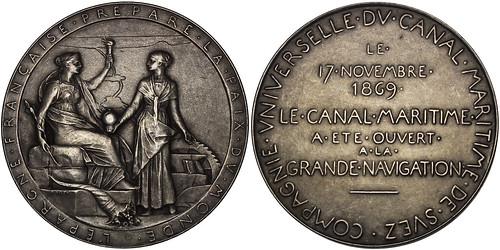
100433 | FRANCE & EGYPT. Compagnie Universelle du Canal Maritime de Suez silver Medal. Dated 1869. The Opening of the Suez Canal (42mm, 47.98 g, 12h). By O. Roty.
L'EPARGNE FRANÇAISE PRÉPARE LA PAIX DV MONDE, Progress, holding branch and torch, seated right on bundled package; overflowing cornucopia below; to right, Industry standing left; implements of manufacture to outer right; outline of canal in background / COMPAGNIE VNIVERSELLE DV CANAL MARITIME DE SVEZ / AU CENTRE LE / 17 NOVEMBRE / 1869 / LE CANAL MARITIME / A ETE OUVERT / A LA / GRANDE NAVIGATION in seven lines. Edge: «cornucopia» ARGENT.
Divo 606; Peltzer 2409. Mint State. Charming matte surfaces with an attractive old cabinet tone; a few lightly scattered hairlines.
Formed in 1868, the Compagnie Universelle du Canal Maritime de Suez was held primarily by French private investors, with some capital coming from Egypt as well. Shortly after its opening, the Khedive of Egypt and Sudan, Ismail Paşa, faced severe debt in his realm, and was forced to sell his shares of the company to the British government. For the next 80 years, the French and British held all of the shares of the canal company, and the British used this foothold to increase their influence in Egypt. In 1956, however, European control of the canal zone came to pass, as Egyptian President Gamal Abdel Nasser nationalized the canal and restricted Israeli usage. The Suez was also a key issue in the Arab–Israeli wars of 1967 and 1973, before finally returning to regular usage under Egyptian control. The original compagnie finally became defunct following its merger with Lyonnaise des Eaux, which resulted in the formation of Suez S.A.
Great medal for a great engineering achievement. -Editor
To read the complete item description, see:
http://numismagram.com/product-page/100433
Bosphorus Bridge Medal

100425 | TURKEY. Bronze Medal. Dated 1973. Commemorating the Opening of the Boğaziçi Köprüsü (Bosphorus Bridge) and the 50th Anniversary of the Republic (75mm, 165.90 g, 12h). By A. Kumuk.
BAYINDIRLIK B KARAYOLLARI G MD 17 BÖLGE BOǦAZIÇI KÖPRÜSÜ AÇILIŠ HATIRASI, view of the suspension bridge with the Hagia Sophia below in foreground; star and crescent in sky / CUMHURIYETIN 50 YILINDA / ASYADAN AVRUPAYA, view of Europe, western Asia, and northern Africa, with an inset zoom view of the Turkish Straits; star, polylobe, and floral scrolls in exergue. Edge: Plain.
Cf. Sincona 13 (16 October 2013), lot 3034 (for a similar, yet inferior, example which realized a total of ChF 360 [after buyer's fee]). As Issued. Enchanting bronzing, with layered hues. Very rare.
Officially known as the 15 Temmuz Şehitler Köprüsü (15 July Martyrs Bridge), the Bosphorus Bridge is the first of three suspension bridges crossing the Bosphorus Strait, and was opened for traffic on 30 October 1973, one day after the 50th anniversary of the founding of the Republic of Turkey. Its construction marked the first such bridge to cross the Bosphorus since the time of the Persians, some 2,400 years prior.
A nice medal for a important bridge. -Editor
To read the complete item description, see:
http://numismagram.com/product-page/100425
Zdeněk Michael František Burian silver Medal

100462 | CZECHOSLOVAKIA. Zdeněk Michael František Burian silver Medal. Dated 1984. Commemorating the Life of the Famous Painter, Illustrator, and Palaeoartist (40mm, 31.35 g, 12h). By L. Havelka.
1905 + 81 Z • BURIAN, bare head right / Tyrannosaurus Rex advancing right, head left. Edge: Plain.
Gem Mint State. Most attractively toned, with hints of goldenrod, sea foam green, cobalt and burnt sienna throughout, along with an alluring underlying tone.
Born in 1905 in the Austro-Hungarian Empire, Zdeněk Burian would come to play an important role in the development of palaeontological art and reconstruction. Through the government run Czechoslovakian publishing house, Artia, his work, especially on dinosaurs, reached a western audience beginning in the 1950's and 1960's, and offered a vivid, lifelike picture into the prehistoric world. It's hard to imagine the dinosaur "craze" of the 1980's and 1990's without him.
Gotta love the dinosaur! -Editor
To read the complete item description, see:
http://numismagram.com/product-page/100462
THE BOOK BAZARRE
NUMISMATIC NUGGETS: NOVEMBER 4, 2018
Here's a selection of interesting or unusual items I came across in the marketplace this week. Tell us what you think of some of these. -Editor
1795 Spence Anti-Slavery Farthing
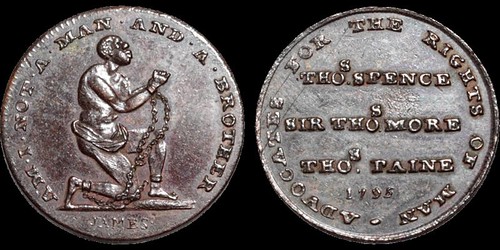
Middlesex 1118 (R). Spence. Æ farthing. 2.97 gm. 20 mm. A slave in chains kneeling right; AM I NOT A MAN AND A BROTHER around, JAMES below / THOS. SPENCE | SIR THOS. MORE | THOS. PAINE | 1795 in four lines, ADVOCATES FOR THE RIGHTS OF MAN around.Good Extremely Fine; toned. Rare.
The anti-slavery farthing shows up less often than the halfpenny token.
From Davissons E-Auction 28 -Editor
To read the complete lot description, see:
E-Auction 28 Lot 120 (https://davcoin.com/lot/e-auction-28-lot-120)
Denmark 16 skilling Gaming Token

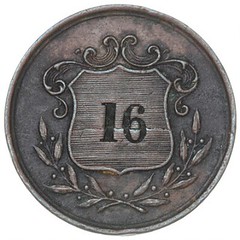
Older gaming token, CARL GINDERUP, 16 skilling, copper, 24 mm, ES 1372, scarce
Only very few pcs known.
Unusual item. I like it! -Editor
To read the complete lot description, see:
Older gaming token, CARL GINDERUP, 16 skilling, copper, 24 mm, ES 1372, scarce
(https://bruun-rasmussen.dk/m/lots/8F49AD614E85)
1936 Venice Film Festival Award Medal

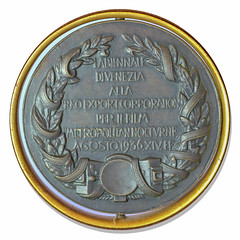
1936 Venice Film Festival award presented to RKO Export Corporation for the film ''Metropolitan Nocturne'', given in the fourth year of what is one of the world's oldest film festivals. Bronze medal pivots in its custom gilt and wood frame, featuring a relief of the winged lion on front and ''IV Mostra Internazionale d'Arte Cinematografica Venezia''. Medal measures 4'' in diameter, housed in the 9'' x 7.5'' x 3'' frame. Discreet nicks to base of frame, otherwise near fine condition.
Earlier we discussed the Directors Guild of America Medal. Here's a nice companion piece - a 1936 Venice Film Festival Award Medal. -Editor
To read the complete lot description, see:
1936 Venice Film Festival Award Medal -- Given to RKO for the Film
''Metropolitan Nocturne'' (https://natedsanders.com/1936_Venice_Film_Festival
_Award_Medal____Given_to_-LOT50637.aspx)
To read the earlier E-Sylum article, see:
NUMISMATIC NUGGETS: OCTOBER 21, 2018 : Directors Guild of America Medal
(http://www.coinbooks.org/v21/esylum_v21n42a29.html)
Apollo 16 Bronze Medal
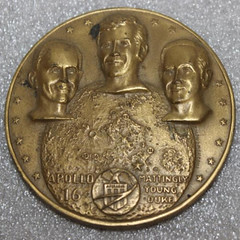
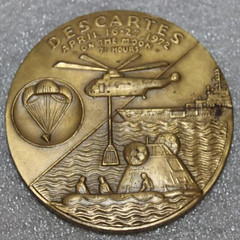
A Medallic Art Company product. A little busy, but still nicely done. Would anyone know who the artist is? -Editor
To read the complete lot description, see:
Lot 8670: An Apollo 16 Bronze Medal (https://www.invaluable.com/auction-lot/-1-c-7B34B759A1)
1987 National Security Council
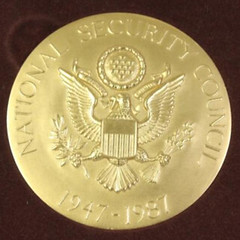
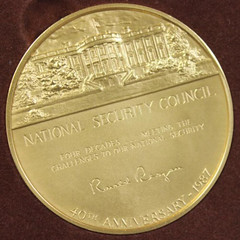
I've never seen one of these before. This one's a little on the plain side, but still a nice medal. -Editor
To read the complete lot description, see:
Lot 8942: National Security Council Gold Plated Medal
(https://www.invaluable.com/auction-lot/-1-c-AB94E98BA4)
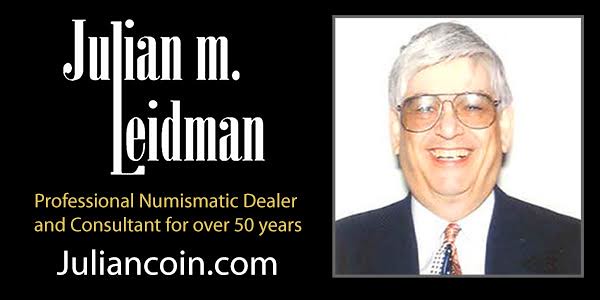
2018 TEMPTATION OF THE SUCCUBUS
This week I came across the web site of Canadian private minting company Pheli Mint. Featured on their home page was a wonderful plaster for anew silver round product. -Editor
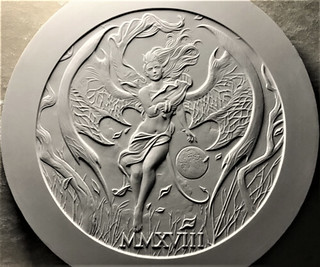 The winning design for our 2018 Temptation of the Succubus 2oz fine silver round is here, the third design for this annual series! A BIG thank you to our friends and
supporters for helping us throughout the design phase and helping us to choose the winning design.
The winning design for our 2018 Temptation of the Succubus 2oz fine silver round is here, the third design for this annual series! A BIG thank you to our friends and
supporters for helping us throughout the design phase and helping us to choose the winning design.
The plaster has arrived! We're one step closer to final product, now to make the epoxy mold and then dies! Stay tuned for more updates!
The company ran an online contest for graphic designers. Here's how they envisioned the 2017 design. -Editor
The Succubus has a metaphorical meaning for us, representing the struggles against any form of alluring temptation; so it is a must that she is represented this way. She needs to be seductive, beautiful, alluring and tempting however not sexually suggestive or pornographic. We would like to give the artists free artistic reign. We want her to appear more seductive, more sexually appealing with less clothing while still being tasteful (no nudity, no sexually suggestive poses). We do like larger wings, and we would like to see a larger portrait of her face. As far as the other "typical" succubus features like horns, tail, finger nails etc...we give you free creativity. With regards to the background details, we wanted to try to incorporate some of her male victims, whether they appear as discarded corpses or otherwise captured men.
To see all the submitted designs, see:
Help us with Beautiful Art for our 2017 Temptation of the Succubus
silver coin! (https://99designs.com/illustrations/contests/help-beautiful-art-temptation-succubus-silver-coin-723818)
The sensual and lifelike design reminded me of the work of sculptor Heidi Wastweet. It's nice to see a commercial site discussing the behind-the-scenes work that goes into creating a new numismatic product. Silver rounds don't have to be bland and uninspired. Some exhibit great design and workmanship; others can express political themes in the great tradition of medallic art. Here's another piece marketed on their site. -Editor
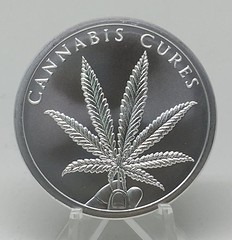

2018 Cannabis Cures by Silver Shield
I reached out to them by email and cofounder Phil Beauchamp kindly provided additional information about the plaster and sculpt. See the following new articles. Thanks! The plaster was created by Luigi Badia. -Editor
To read the articles, see:
Creating a Coin Die: Turning art into a mold!
(https://www.phelimint.com/blogs/learning-centre/creating-a-coin-die-turning-art-into-a-mold)
How Coin Dies are Created using a Pantograph.
(https://www.phelimint.com/blogs/learning-centre/how-coin-dies-are-created-using-a-pantograph)
For more information, see:
https://www.phelimint.com/
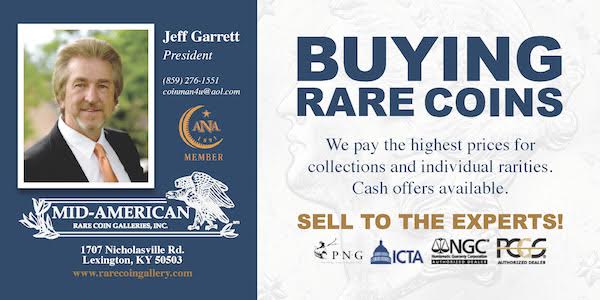
MORE NEWMAN SALE X CURRENCY HIGHLIGHTS
Here are some more highlights from the upcoming Heritage sale X of currency from the Eric P. Newman collection. -Editor
The sales of Selections from the Eric P. Newman Collection are coming to an end this week, with Newman Part X and Newman Part XI (presented in two separate catalogs) closing the series of auctions that began in 2013. These eclectic sales include paper currency, coins, coin-related devices, books, auction catalogs, and archives.
The Signature sessions will be held in Dallas at Heritage Auctions on Wednesday, November 7, and the Internet sessions will close on Saturday, November 10. The Newman sales offer something for everyone, regardless of collector level or budget. Please be sure and visit HA.com for more information.
U.S. and World Paper Currency
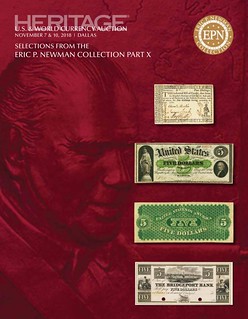 The Newman Collection auctions have presented one of the greatest opportunities ever in paper money collecting, with thousands of notes being studied and enjoyed by
countless numismatists. Though this sale is compact (431 lots total), it is still laden with rare, important, and seldom-seen notes. Some highlights are below:
The Newman Collection auctions have presented one of the greatest opportunities ever in paper money collecting, with thousands of notes being studied and enjoyed by
countless numismatists. Though this sale is compact (431 lots total), it is still laden with rare, important, and seldom-seen notes. Some highlights are below:
The catalog includes a special section on Continental Currency contemporary counterfeits. From the 1980s onward, Eric P. Newman and Stuart Levine studied and discussed these circulating counterfeits. Newly updated and clarified diagnostics of the Eric P. Newman Reference Collection (Signature lots 20046-20091 and Internet lots 20412-20424) are published for the first time. Among these notes are the rare and distinctive counterfeit "Fugio" $2/3 note. ha.com/3568- 11362.
Another significant area in the catalog focuses on Eric's groundbreaking Audubon research. The notes, sample sheets, and original hand-colored first edition engraving used to illustrate the 2010 Newman and Peck article, "Discovered! The First Engraving of an Audubon Bird," are presented in this sale. Five seldom-offered engraver's sheets (lots 20103-20107) and three notes (20108- 20110) all showing the Audubon “Running Grouse†are featured. Lot 20106, the very rare 1830- dated Fairman, Draper, Underwood & Co. sample sheet, shows a pair of Audubon's "Running Grouse" vignettes.
Missouri notes were especially relevant to Eric, dating back to the original Green acquisition that formed the core of his important collection. There are 32 Missouri lots (20132-20163), and many are great rarities. Two early “Bon†scrip (20132-20133) lead into a short section of territorial period scrip and banknotes. The 1817 “Partial View of St. Louis†$10 from the 1 st Bank of St. Louis (lot 20142) is in beautiful condition and pairs nicely with a choice 1859 2nd Bank of St. Louis $10 note (20150). Eric’s original Missouri Currency inventory book is featured as well (lot 20163) and includes the Green collection Missouri National Bank notes and the Obsolete notes.

The note offered as lot 20142, the "Partial View of St. Louis," is particularly meaningful, as it was Eric who discovered and dated it the view to 1814. Eric identified all the landmarks in his 1941 article, "Earliest View of St. Louis."
To read the complete lot description, see:
https://currency.ha.com/itm/obsoletes-by-state/missouri/st-louis-missouri-ty-bank-of-st-louis-1st-10-mar-18-1817-mo-45-g26-pcgs-very-fine-30/a/3568-20142.s
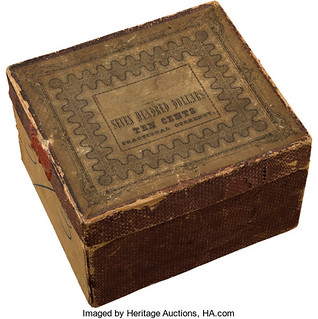
This sale also has one of the most interesting items related to United States currency ever encountered. It is an original U.S. Treasury transmittal box for $700 worth of 10 cents in fractional currency (lot 20203). For decades, legend had it still sealed and filled with notes. It is empty, but is immensely desirable and we know of no other. Fractional currency collectors will be excited when this crosses the auction block.
Unbelievable. I collected Fractional notes for years but never knew this existed. What a prize! -Editor
To read the complete lot description, see:
https://currency.ha.com/itm/small-size/legal-tender-notes/united-states-treasury-seven-hundred-dollars-in-ten-cents-fractional-currency-official-cardboard-transmittal-box-very/a/3568-20203.s
To read the earlier E-Sylum article, see:
NEWMAN SALE X CURRENCY HIGHLIGHTS (http://www.coinbooks.org/v21/esylum_v21n43a16.html)

MORE NEWMAN SALE XI VOLUME 1 COIN HIGHLIGHTS
Here are some more highlights from the upcoming two-volume Heritage sale XI of the Eric P. Newman collection. -Editor
U.S. Coins, World Coins, and Coin-Related Devices
Plus Newman Library Internet Session
Lot 15046: Washington - Franklin American Beaver Medal
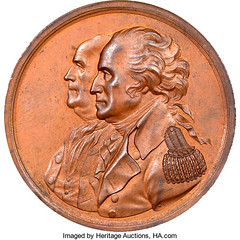
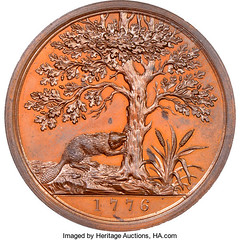
1776-Dated Washington - Franklin, American Beaver, MS64 Red and Brown NGC. Baker-54A, Betts-549, Julian CM-4, Greenslet-83, Musante GW-93. Bronze, plain edge, 40 mm. An early American effort by noted engraver John Reich, whose redesign of U.S. coinage soon followed. Julian CM-4 through CM-8 are often called Sansom medals, since their issue was sponsored by Philadelphia businessman Joseph Sansom. The dies were finished in 1805, but intermittent strikes continued some years thereafter. The obverse presents half-length busts left of George Washington and Benjamin Franklin. The busts overlap, with Washington in front. The reverse depicts an American beaver gnawing through a British oak tree. A splendid near-Gem of this expertly engraved high-relief variety. Well struck, mark-free, and with ample faded peach-gold color. The portrait high-points are steel-gray.
To read the complete lot description, see:
https://coins.ha.com/itm/u.s.-mint-medals/1776-dated-washington-franklin-american-beaver-ms64-red-and-brown-ngc-baker-54a-betts-549-julian-cm-4-greenslet-83-m/a/1283-15046.s
Lot 15058: 1486 Austria Sigismund Guldiner
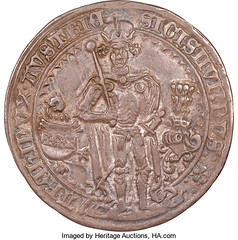
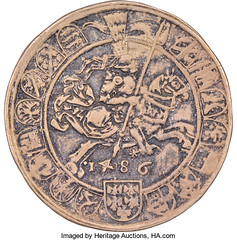
1486 Austria (Tyrol) Sigismund Guldiner, XF40 NGC. Dav-8087. A quintessential coin, often dubbed the "first Taler," this charming specimen is here seen in a level of presentation and originality that is virtually unmatched by any example that we have encountered to-date. The strike is of admirable quality, and the obverse is sheathed in a fine ashen patina, likely centuries-old. The reverse is equally impressive, exhibiting a lighter sandy hue with a similar degree of strong detail. A wondrous offering, one that is likely to serve as a centerpiece of its future owner's cabinet.
To read the complete lot description, see:
https://coins.ha.com/itm/world/1486-austria-tyrol-sigismund-guldiner-xf40-ngc-dav-8087/a/1283-15058.s
Lot 15098: W.H. Ells English Gold Coin Changer
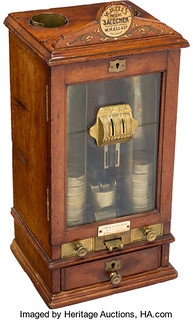
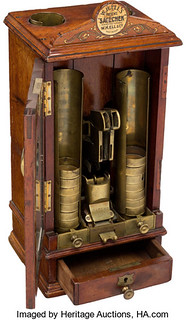
W.H. Ells English Gold Coin Changer. Fine. A turn-of-the-century English gold coin changer for converting sovereigns and half sovereigns into equivalent amounts of silver coinage. The body is made of wood, with brass fittings and a glass pane in the hinged front door. There is a crack in the glass pane. The door has a brass fitting with slots for depositing sovereigns and half sovereigns. Behind the glass, a large central column holds a mechanism for receiving the gold coins, inscribed PATENT/22067.
Two flanking columns hold a number of circular brass holders designed to deliver the silver coins through two drawers below the door. A locked money box is at the bottom. A painted wooden medallion at the top reads W.H. ELLS/PATENT/"SAFECHECK"/ MANUFACTURERS/ W.H. ELLS & CO./REG DESIGN. An enameled white plaque on the door reads LUND & REYNOLDS Ltd/BAR FITTERS/BRADFORD. Two brass tubes in the top include some rolled up correspondence and a patent application from 1904. Several keys to the door and money box are inside the bottom drawer. The dimensions are approximately 8.3 x 7 x 17.5 inches.
To read the complete lot description, see:
https://coins.ha.com/itm/miscellaneous/wh-ells-english-gold-coin-changer-fine/a/1283-15098.s
Lot 15061: 1839 South Peru 8 Reales
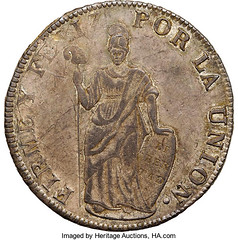
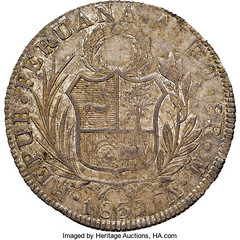
1839 Areq-MV Peru (South Peru) 8 Reales, AU55 NGC. KM142.7. Arequipa mint. Here is one of the rarities of Peruvian coinage. This early Republican issue is virtually never encountered. When it does appear, it is most often damaged or low grade. The coin offered here is a lovely toned example with soft gray patination and strong underlying luster. The standing female symbolizing Liberty dominates the obverse; she carries a capped pole and rests her hand on a shield inscribed LI/BER/TAD. The reverse has a wreath above arms, with sprigs at both sides and date below.
Arequipa is a major manufacturing center in southern Peru today, but was far less influential at the time of independence. 4 Reales coins were minted in some quantity in the 1840s but virtually no 8 Reales coins with the figure of Liberty were issued. It is a great privilege to offer such a rarity, further enhanced by its exceptional condition.
To read the complete lot description, see:
https://coins.ha.com/itm/world/1839-areq-mv-peru-south-peru-8-reales-au55-ngc-km1427/a/1283-15061.s
Lot 15065: Allender Gold Coin Detector
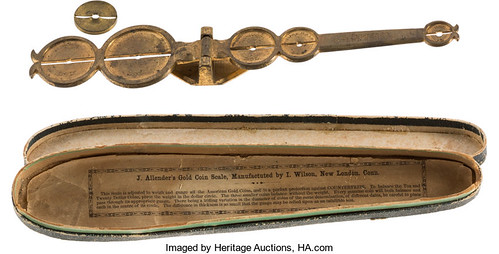
John Allender's Gold Coin Detector, With Rare Three Dollar Insert. Fine. A pre-1854 model of John Allender's brass gold coin counterfeit detector, manufactured by I. Wilson, New London, Connecticut. The scale's beam contains circular slots for the five denominations of U.S. gold coins issued before the three dollar denomination was introduced in 1854.
A very rare insert (intended to be placed inside the five dollar slot for use) is included to handle the new three dollar denomination, patent pending. Housed in the original oblong cardboard box, with internal instruction letter pasted to the bottom. A short descriptive note on a circular tag from Eric P. Newman, accompanies the lot. Approximate dimensions: 8.7 x 1.7 x 0.8 inches.
To read the complete lot description, see:
https://coins.ha.com/itm/miscellaneous/john-allender-s-gold-coin-detector-with-rare-three-dollar-insert-fine/a/1283-15065.s
Lot 15084: 1850 Miners' Improved Gold Scale

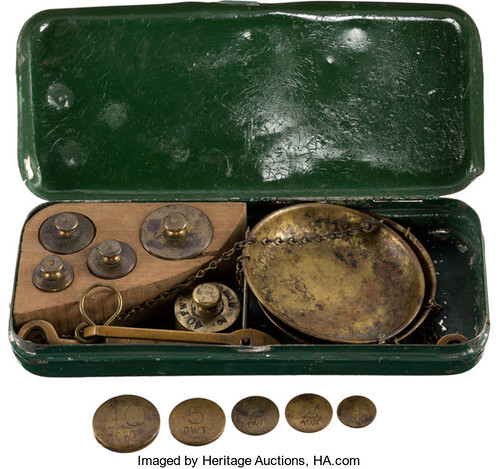
Circa 1850 Miners' Improved Gold Scale Manufactured Expressly for California. Extremely Fine. The green-painted tin box measures 7.2 x 3.1 x 1.2 inches with gilt lettering, a flying eagle, and a ribbon bearing the motto E Pluribus Unum. The paint is mostly intact on the outside of the box and is partially worn away on the inside. The scale is brass construction and shows minor corrosion. The scale arm is 6.9 inches, and the pans are 2.8 inches diameter. A wood block inside the case holds ½, 1, 2, and 4 ounce weights. An extra 2 ounce weight is included, with 10, 5, 2, 2, and 1 dwt. weights, permitting a capacity of 10.5 ounces. Eric P. Newman identified this scale as a product of Germany, although no markings are seen.
To read the complete lot description, see:
https://coins.ha.com/itm/miscellaneous/circa-1850-miners-improved-gold-scale-manufactured-expressly-for-california-extremely-fine/a/1283-15084.s
To read the earlier E-Sylum article, see:
NEWMAN SALE XI VOLUME 1 COIN HIGHLIGHTS (http://www.coinbooks.org/v21/esylum_v21n43a17.html)

MORE NEWMAN SALE XI VOLUME 2 LITERATURE HIGHLIGHTS
Here are some more highlights from the upcoming two-volume Heritage sale XI of the Eric P. Newman collection. This is literally a once-in-a-lifetime opportunity to acquire great numismatic literature rarities that have been off the market for decades. -Editor
Newman Library
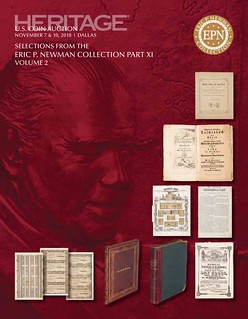 This week's one and only Newman Library sale promises to be an electrifying event, and online access is even easier than before. From the DEPARTMENTS menu,
select Books & Historical Manuscripts, and choose All Books & Historical Manuscripts. The Newman XI Library Sale information will pop up instantly.
This week's one and only Newman Library sale promises to be an electrifying event, and online access is even easier than before. From the DEPARTMENTS menu,
select Books & Historical Manuscripts, and choose All Books & Historical Manuscripts. The Newman XI Library Sale information will pop up instantly.
Many rarities are presented in this historic offering of Eric P. Newman's books, archives, and plated auction catalogs. Collectors are encouraged to view the archives in particular, with the Virgil Brand, Roger Cohen, Burdette G. Johnson and Bernard Edison (R. Tettenhorst) papers as well as correspondence files between Eric P. Newman and ANACS, the Assay Commission, Douglas B. Ball, Harry W. Bass, F.C.C. Boyd, and more. Not to be missed is the archival material relating to the "Colonel" Green Collection: The Deal of the Century.
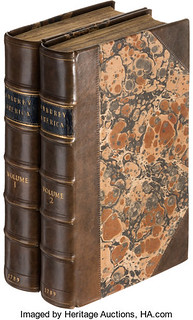 This week's article is focused on books, and we would like to point out lot 15152, Thomas Anburey's Travels through the Interior Parts of America. This
complete, two-volume 1789 work contains plates depicting both sides of Continental Currency notes: a July 22, 1776 $3; a Nov. 2, 1776 $6; a 14th January, 1779 $50; and a 14th
January, 1779 $65.
This week's article is focused on books, and we would like to point out lot 15152, Thomas Anburey's Travels through the Interior Parts of America. This
complete, two-volume 1789 work contains plates depicting both sides of Continental Currency notes: a July 22, 1776 $3; a Nov. 2, 1776 $6; a 14th January, 1779 $50; and a 14th
January, 1779 $65.
To read the complete lot description, see:
https://coins.ha.com/itm/books/-anburey-thomas-travels-through-the-interior-parts-of-america-in-a-series-of-letters-by-an-officer/a/1283-15152.s
Eric's complete collection of Heath's Counterfeit Detectors comprises a major offering in this sale, and they are introduced by a reprint of Eric's fascinating 1991 article, "Heath's Counterfeit Detectors: An Extraordinarily Successful Comedy of Errors."
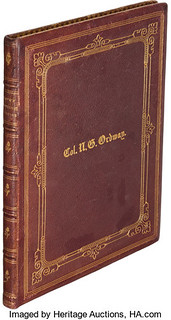
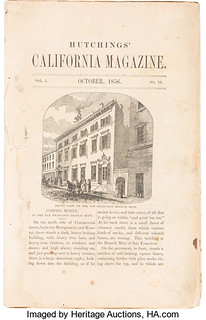
Lot 15286, the 1870 third edition Banking House & Counting Room Edition shows an impression of a counterfeit $10 National Bank of Philadelphia note. ha.com/1283-11169. The beautiful full morocco presentation edition prepared for Col. Nehemiah G. Ordway is offered as lot 15298.
To read the complete lot description, see:
https://coins.ha.com/itm/books/heath-laban-heath-s-greatly-improved-and-enlarged-infallible-government-counterfeit-detector-at-sight/a/1283-15298.s
Another rarity, Hutchings' California Magazine, vol. 1, No. 4, contains a fascinating early illustrated account of the San Francisco Mint. Offered as lot 15320, it covers nearly the entire minting process starting from a bag of gold being placed on the Treasurer's counter.
To read the complete lot description, see:
https://coins.ha.com/itm/books/hutchings-and-co-jm-publisher-hutchings-california-magazine/a/1283-15320.s
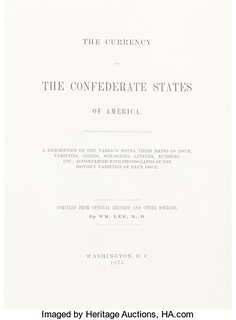
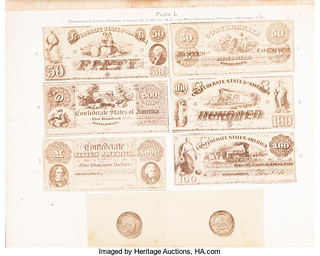
From 1875, William Lee's rare, photographically illustrated book, The Currency of the Confederate States of America, is the foundational work on Confederate paper money. It is also the first book to describe and photograph the Confederate cent. With half of the only 10 known today held by institutions, this offering of lot 15330 is a rare opportunity.
One of the greatest rarities of American numismatic literature. I looked for years and never found one I could afford for my library. A great opportunity. -Editor
To read the complete lot description, see:
https://coins.ha.com/itm/books/lee-wm-the-currency-of-the-confederate-states-of-america/a/1283-15330.s
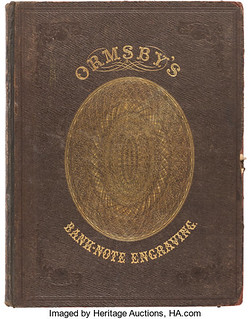

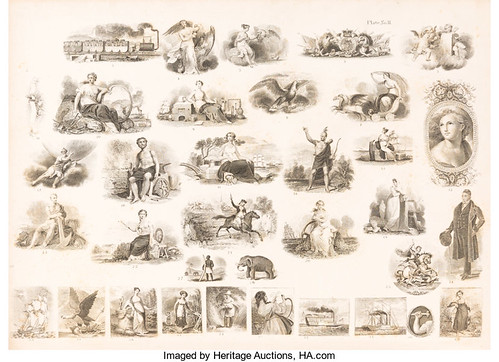
Ormsby's Magnificent 1852 work on American bank note engraving, lot 15368, is exceptionally well illustrated and is the most desirable volume ever published on the subject. Ormsby was the proprietor of the New York Bank Note Company and one of the founders of the Continental Bank Note Company, and his insights into the topics covered are unparallelled.
The Ormsby isn't quite as rare, but it's still a prize for any American numismatic library. -Editor
To read the complete lot description, see:
https://coins.ha.com/itm/books/ormsby-wl-a-description-of-the-present-system-of-bank-note-engraving-showing-its-tendency-to-facili/a/1283-15368.s
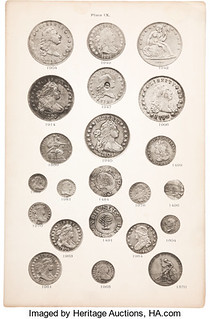 Lot 15407, Woodward's rare Vicksburg Sale catalog contains 12 photographic plates, the last of which is gold-tinted. The section on American Colonial coins is neatly
hand-priced in red ink.
Lot 15407, Woodward's rare Vicksburg Sale catalog contains 12 photographic plates, the last of which is gold-tinted. The section on American Colonial coins is neatly
hand-priced in red ink.
To read the complete lot description, see:
https://coins.ha.com/itm/books/woodward-w-elliot-assisted-by-ed-frossard-catalogue-of-a-collection-of-coins-and-medals-selected-from-a-large-cabinet/a/1283-15407.s
As in the previous auctions, items being sold are from the extensive collection of the Eric P. Newman Numismatic Education Society (a Missouri not-for-profit corporation), and have been assembled over a period of 90 years. Proceeds of the sale of all items will be used exclusively for supplementing the Society's scholarly research efforts and for the benefit of other not-for-profit institutions selected by the Eric P. Newman Numismatic Education Society for public purposes.
To read the earlier E-Sylum article, see:
NEWMAN SALE XI VOLUME 2 LITERATURE HIGHLIGHTS (http://www.coinbooks.org/v21/esylum_v21n43a18.html)
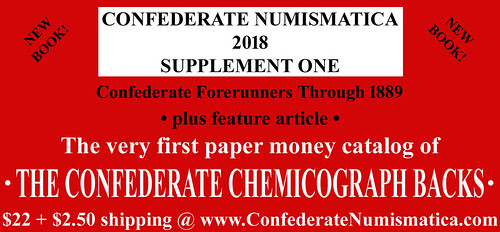
GOLDBERG'S OFFERS RARE JUDAEAN MATERIAL
Here's the press release for an important group of Judaean and related coins in the upcoming Goldberg’s sale. -Editor
Extremely Rare Judaean and Judaean-Related Roman Coins Featured in Goldberg’s New York Sale
Once every few years, an auction of Judaean material of the highest caliber is held, and this will be the case when the combined Palm Desert Collection and the collection of Shlomo Moussaieff consisting of over 150 extremely rare Judaean and Judaean- related Roman Coins will be auctioned in the New York Sale held by Goldbergs Auction from January 8-10. The catalog and prices will serve as a guidebook to the popular field of Biblical Numismatics for many years. Goldberg’s New York Sale catalog can be obtained by calling (310) 551-2646; it is regularly priced at $25, but mention that you read about it in E-Sylum and pay only $15 in U.S. or $20 overseas. The catalog will soon be on view at www.goldbergcoins.com.
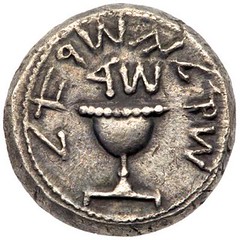
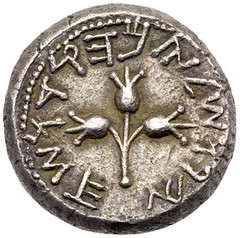
Auctioneer Ira Goldberg indicates that this may be the first auction to ever feature two extremely rare Year 4 shekels, one of which is shown above.
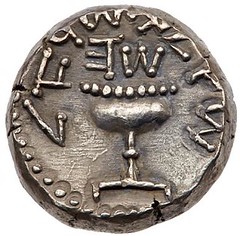
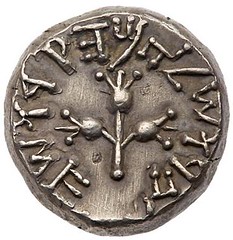
This superb Year 5 shekel would be the prize of any ancient Judaean collection. The Shoshana specimen sold for nearly $90,000 in 2012.
Shekels form the heart of any ancient Judaean coin collection, and there is a remarkable group in the Palm Desert Collection, including one or more half shekels from Year 1, 2 and 3 of the First Revolt (66-70 CE) and for the first time ever in one sale—two extremely rare shekels produced in Year 4 plus the ultimate rarity--a Year 5 shekel; each of these is Extremely Fine or better. The coins of the Second Revolt (132- 135 CE) are also rich in rarities. Highlighting about a half dozen selas (tetradrachms) is a Year 1 with the Hebrew inscription “JERUSALEM†surrounding the Temple; a Year 2 with the under-coin of Galba clearly visible, including the Emperor’s profile and parts of the inscription; and a Year 3 with the enigmatic wavy line above the Temple. Plus a nice selection of bronzes and zuzim (denarii).
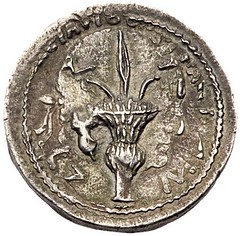
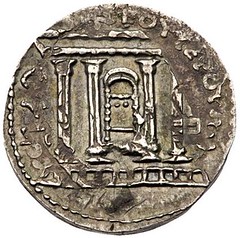
This sela, dated in Year Two (133/134 CE) of the Second Revolt, was struck over a tetradrachm issued by the Roman Emperor Galba, who reigned briefly for seven months from 68 to 69 CE (while the First Revolt was still in full swing!). His right-facing profile is clear above (left). While virtually all of the silver coins produced by the Jews during the Second Revolt were struck over Roman coins, it must have given the minter great satisfaction to strike over this coin, in particular, produced by the enemy of the Jews during their previous revolt against Rome.
In addition to rare shekels, half shekels, selas and zuzim of the First Revolt (66-70 CE) and Second Revolt (132-135 CE), the Palm Desert Collection in Goldberg’s New York Sale, collectors will be especially interested in a modest number of extremely rare Judaean-related Roman coins. These coins are less often encountered at dealers and auctions because they are never found in quantity in hoards. Judaean coins were buried at the time of these wars for safekeeping, but there was never any reason for Romans to bury Judaean-related coins.
The earliest Judaean-related Roman coin is an extremely fine tetradrachm, with superb portraits of Cleopatra and her lover Mark Antony, that was issued in Akko.
The most comprehensive and well known Judaean-related Roman coin series is “Judaea Capta,†consisting of bronze, silver and gold coins celebrating the Roman victory over Judaea in 70 CE. The vast majority of these coins carry the inscription JUDAEA CAPTA, JUDAEA AUGUST or JUDAEA, however some of the rarer varieties do not—including some of the coins in the Goldberg sale: a Vespasian sestertius with the hybrid inscription JUDAEA AUGUST, a Vespasian aureus inscribed DE JUDAEIS, minted at Lugdunum, c. 72 CE, and another aureus of Vespasian depicting two Jewish captives before triumphant Roman soldiers, horses, etc., with TRIUMP AUG in exergue.

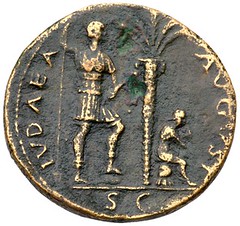
Judaea Capta type sestertii generally have the inscription IVDAEA CAPTA or VICTORIA AUGUSTI, but this extremely rare hybrid features the strange legend IVDAEA AUGUST.
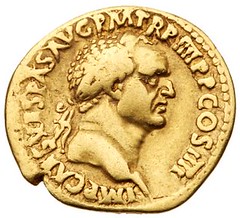
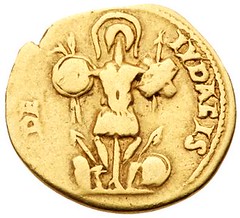
Very rare Judaea Capta type gold aureus features a Roman trophy with the inscription DE IVDAEIS, minted at Lugdunum (modern Lyon, France).
The singularly important Judaean-related Roman coin issued in between the two Jewish revolts against Rome features the Emperor Nerva (96-98 CE) and a palm tree surrounded by the inscription FISCI JUDAICI CALUMNIA SUBLATA (the abuses of the Jewish Tax are ended) and SC (Senatus Consulto = by consent of the Senate).
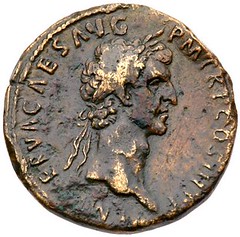
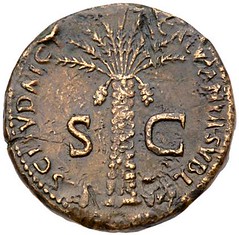
Nerva’s enigmatic inscription FISCI JUDAICI CALUMNIA SUBLATA on this sestertius offered in the Palm Desert Collection has inspired numerous articles attempting to explain its meaning.
The event that might have ignited the Second Revolt (132-135 CE), the visit of Hadrian to Jerusalem in 131 CE—where he stated his plans to convert the Jewish Temple to a Roman one—is commemorated on two very rare bronze coins in the Goldberg Sale. On the first coin, a sestertius, Hadrian is greeted by a female (representing the Roman province of Judaea) who hands the Emperor a dove, and he in turn is offering her an olive branch of peace, with three small Jewish figures in the background, surrounded by the inscription ADVENTU AUG JUDAEA and S.C. in exergue. The second coin, an “as†denomination, commemorates the same event but is even rarer as a type and denomination; it features Hadrian with an arm outstretched to a kneeling female representation of Judaea, and three small Jews (one carrying olive branch) in the background; the inscription is JUDAEA in exergue.
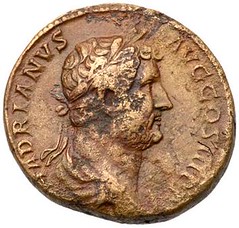
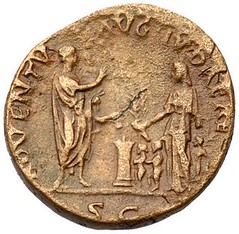
Hadrian’s ADVENTU AUG JUDAEA coin is a virtually unknown “as†denomination. Note that the name sestertius means "two and one half," referring to its nominal value of two and a half asses.
Beginners and advanced collectors of Biblical Coins will find lots ranging from small bronze leptons issued by Roman Prefects and Procurators of Judaea, estimated at under $100 each, to an extremely rare Year 5 (70 CE) shekel of the First Revolt, that is expected to bring somewhere in the high five-figures.
AN 18TH CENTURY COIN FIND IN BULGARIA
Found via The Explorator newsletter: an 18th century coin find in Bulgaria. -Editor
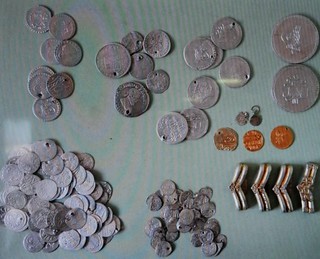 A hoard of 854 silver and gold coins from the Ottoman Empire and Western Europe from the mid-18th century as well as jewelry have been discovered by archaeologists
hidden in a treasure pot in late medieval ruins in the Bulgarian Black Sea town of Ahtopol, the successor of the ancient and medieval city of Agathopolis.
A hoard of 854 silver and gold coins from the Ottoman Empire and Western Europe from the mid-18th century as well as jewelry have been discovered by archaeologists
hidden in a treasure pot in late medieval ruins in the Bulgarian Black Sea town of Ahtopol, the successor of the ancient and medieval city of Agathopolis.
The discovery was made inside the Late Antiquity and medieval fortress of Agathopolis during the excavations of Ottoman Era homes, archaeologist Andrey Aladzhov from the National Institute and Museum of Archaeology in Sofia has revealed during a conference in Ahtopol.
The finding of the Ottoman Era treasure pot from the Late Antiquity and medieval fortress of Agathopolis in Southeast Bulgaria is the second archaeological discovery of this type on Bulgaria’s Black Sea coast in 2018, after a treasure pot of Tatar plunder from ca. 1400, also containing both coins and jewelry, was discovered in the Kaliakra Fortress in August on Cape Kaliakra in Northeast Bulgaria.
A total of 851 of the Ottoman and Western European coins from the treasure pot discovered during the recent digs in Ahtopol are silver, and three are gold.
Most of the coins in question were minted by two rulers of the Ottoman Empire, Sultan Mahmud I (r. 1730 – 1754), and his brother and successor, Sultan Osman III (r. 1754 – 1757),
Many of the coins in the photo are holed. Used as jewelry, perhaps? -Editor
To read the complete article, see:
HOARD OF 18TH
CENTURY OTTOMAN, WESTERN EUROPEAN COINS FOUND IN TREASURE POT IN BULGARIA’S BLACK SEA TOWN AHTOPOL
(http://archaeologyinbulgaria.com/2018/10/28/hoard-of-18th-century-ottoman-western-european-coins-found-in-treasure-pot-in-bulgarias-black-sea-town-ahtopol/)
THE BOOK BAZARRE
CULTURAL PROPERTY NEWS: LATEST COURT RESULTS
Kavan Ratnatunga forwarded a link to this new article from the Cultural Property News on the latest legal happenings in the test case challenge the U.S. State Department’s actions in seizing imported ancient coins. Here's a very short excerpt. -Editor
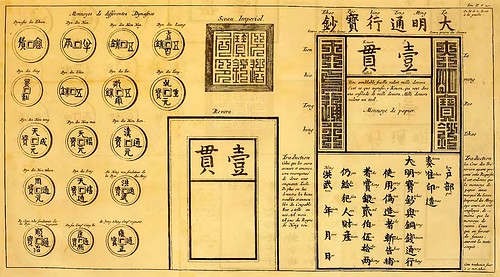
Engraving Description de la Chine, édition de La Haye 1736. Volume 2. Page 201
A lawsuit, U.S. v. 3 Knife-Shaped Coins etc., involving fifteen coins from China and Cyprus, none very beautiful or valuable, began as a test case in 2009, and has been hard-fought at every step by the nonprofit Ancient Coin Collectors Guild (ACCG). An important goal of the test case was to challenge the U.S. State Department’s actions in going far beyond the definitions and requirements set by Congress for import restrictions under the U.S.’s only deliberately crafted and comprehensive international cultural property legislation, the Convention on Cultural Property Implementation Act (CPIA).
The lengthy legal battle has been possible only through the ACCG Board’s commitment to requiring adherence to law in the administration of U.S. cultural property policy. ACCG lead attorney Peter K. Tompa has shown unflagging determination to preserve Congress’s intent in the express language in the statute and to renew the integrity of the review process under the CPIA. The Guild has been equally tireless in pursuit of the public’s interest in due process under the Constitution. A host of amici added their voices (the Committee for Cultural Policy, the publisher of Cultural Property News, was one). Amici included the American Numismatic Association, Professional Numismatists Guild, International Association of Professional Numismatists, Association of Dealers and Collectors of Ancient and Ethnographic Art, and Global Heritage Alliance.
The result, after years of litigation, is that the U.S. Court of Appeals for the Fourth Circuit has affirmed U.S. Customs and Border Protection’s original seizure of the coins, and also re-interpreted the plain language of the CPIA, by promoting ease of enforcement over due process and the legal requirements in the original legislation. In so doing, the Court did not criticize misrepresentations by the State Department to Congress, or its failure to follow the statute’s fundamental principles of balanced review. Finally, the ruling effectively lessens the government’s burden of proof to show that objects were unlawfully imported, a consequence Congress sought to avoid in the original legislation.
How will this decision impact the future ability of collectors to import archaeological and ethnological objects?
The answer depends largely upon the integrity of the review process under the CPIA, both in the recommendations of the Cultural Property Advisory Committee and on ensuring that the State Department’s officials at the Bureau of Educational and Cultural Affairs do not overstep their authority under the law. The decision curtails, at least for the moment, the ability of collectors and dealers to seek a correction to overbroad and unjustified import restrictions and unwarranted seizures by pointing out that the Designated Lists do not comport with the requirements under the CPIA, or that the process creating the existing lists was fundamentally flawed.
It means that until a future correction is made, neither Congressional intent, nor the criteria in the actual law, can set the limits of import restrictions, if the Department of State and the Cultural Property Advisory Committee fail to follow the Cultural Property Implementation Act as it is written.
To read the complete article, see:
An Epic Battle: U.S. v. 3 Knife-Shaped Coin
(https://culturalpropertynews.org/an-epic-battle-u-s-v-3-knife-shaped-coins/)
ROYAL MINT PLANS BREXIT COIN
David Pickup noted that there were many stories out this week about the planned "Brexit 50p" coin. First, here's one by Michael Alexander of Coin Update. -Editor
It was announced and confirmed today by HM Treasury in the United Kingdom that they will officially issue a commemorative coin to mark the departure of the United Kingdom from the European Union, commonly referred to as Brexit. The announcement was made after the delivery of the annual budget speech by the Finance Minister Philip Hammond, who is referred to as the Chancellor of the Exchequer to the House of Commons. Her Majesty’s Treasury will authorise the design and minting of a commemorative coin which will in itself not reference Brexit but instead include the date of departure and is also expected to be branded with a message that partially quotes America’s third president and author if the U.S. declaration of independence, Thomas Jefferson, with the words “Peace, Prosperity, and Friendship with all nations.â€
The issue of a commemorative coin to mark the UK’s departure from the European Union was ostensibly the result of a campaign initiated by the tabloid newspaper, The Sun, which petitioned its readers to support the minting of the new 50-pence coin and had argued “for the Government to create an enduring gesture to mark Brexit as a landmark national moment.†According to The Sun, they have reported from Treasury sources that the department had been secretly working on plans for the Brexit coin for months before Conservative members of Parliament began to campaign for such a commemorative coin.
The iconic seven-sided 50-pence coin was specially chosen, as this was the particular denomination used in 1973 to mark the United Kingdom’s inclusion in the European Economic Community (EEC), a precursor to the European Union. In 1992, for the occasion of the United Kingdom holding the rotating presidency of the European Union commission, a 50-pence coin was issued, and a second 50-pence coin was issued in 1998 with reduced weight and diameter for the same occasion.
To read the complete article, see:
United Kingdom announces that a commemorative
50-pence coin will be issued to mark Brexit (http://news.coinupdate.com/united-kingdom-announces-that-a-commemorative-50-pence-coin-will-be-issued-to-mark-brexit/)
Quite a number of articles and comments have sprung up in response, at least on one numismatic but most political in nature. Here's a numismatic one. -Editor
It will not be the first time that Britain’s relationship with Europe has been marked on its coinage. Commemorative 50p pieces were struck in 1973 when Britain joined the European Economic Community, and in 1998 to mark the UK’s presidency of the EU. But you could argue that the neatest parallel to the Brexit coin goes back almost two millennia, to the third century AD and the first, dramatic Brexit – under Britain’s breakaway Roman emperor, Carausius.
A Roman officer from modern Netherlands, Carausius was given command of a fleet whose job was to rid the Channel of Saxon raiders. But, accused of colluding with the pirates, he was sentenced to death. His response, in about AD 286 or 287, was to seize control of the Roman province of Britannia, along with a chunk of France around Boulogne.
Precisely what was really going on here is hard to unpick; there is hardly anything to go on in the historical record (a fact that probably helped rather than hindered the writer Rosemary Sutcliff in fleshing out a wonderfully compelling account in her children’s book The Silver Branch). But there are strong clues in the distinctive, highly suggestive coins Carausius struck. One declared him “the restorer of Britainâ€, another “spirit of Britainâ€. Another was inscribed with words that translate as “Come, awaited one†– an adaptation of a phrase from Virgil. Another had an image of Romulus and Remus suckled by the she-wolf – the great, resonant image of Rome’s mythical origins – with the inscription, “the restorer of the Romansâ€, along with the rather enigmatic initials RSR. Carausius was claiming to hark back to a better, stronger age.
However, the most intriguing coin he struck was a splendid gold medallion, the sole example of which is in the British Museum, and which I was (thrillingly) allowed to examine and hold when researching my book about Roman Britain, Under Another Sky. The coin, brought into the museum by a little boy in the 1930s, shows Carausius himself dressed in a consular toga (pure fake news, incidentally, since he was never elected consul). The reverse shows Victory in a chariot and the words “victory of Carausius Augustusâ€. Also on the coin are the letters INPCDA.
For years no one had a clue what the letters RSR or INPCDA alluded to. Then, in 1997, it suddenly occurred to the writer and broadcaster Guy de la Bédoyère – while running a bath for his children – that they could perhaps be something to do with Virgil. On the offchance, he flicked through the Oxford Dictionary of Quotations. And there the letters were, right in front of him. RSR stands for redeunt saturnia regna, or “the Golden Age returnsâ€; INPCDA for iam nova progenies caelo demittitur alto – “now a new progeny is sent from heavenâ€. Together, they are the most famous line and a half of Virgil’s Fourth Eclogue – an ecstatic poem foretelling the start of a glorious new era.
To read the complete article, see:
The new 50p has echoes of the first, disastrous Brexit
(https://www.theguardian.com/commentisfree/2018/oct/30/new-50p-brexit-british-coins-europe)
David Pickup forwarded this followup from the Guardian. -Editor
I was both pleased and flattered by Charlotte Higgins’ generous acknowledgment of my discovery of the Virgilian Eclogue tag on the coins and medallions of the rebel Roman emperor Carausius and his regime in Britain (The 50p coin recalls the first, ill-fated Brexit, 31 October).
But Carausius was no antique Brexiteer or Boris Johnson. Quite the reverse in fact. Everything about his propaganda, flaunted on his coins which depict an array of traditional Roman virtues and aspirations, shows that he claimed to be restoring the decrepit, violence-ridden Roman empire – Renovator Romanorum (“Restorer of the Romansâ€), he bragged on one. He never claimed to be restoring Britain.
Carausius was turning the clock back three centuries to the great days of Augustan Rome, so he said, but starting in his power base in Britain. He even opened the first mint in London in order to produce some of his coins.
Had he been around today, far from leading Brexit, the swaggering Carausius would be claiming to be restoring the great aspirations and ideals of the European Union, but in London rather than Brussels.
In short, Carausius was the original remain hero (and martyr).
Guy de la Bédoyère
Welby, Lincolnshire
•Boris Johnson “minted on to a coin wearing a toga and surrounded by quotations†to mark a second ill-fated Brexit? “Per ardua ad calamitasâ€?
Austen Lynch
Garstang, Lancashire
•â€œPeace, prosperity and friendship with all nationsâ€, the words on the proposed 50p piece to celebrate Brexit are OK, but a bit bland. Half a century ago, MLK quoted words that are unsurpassable re the Brexit coin: “Free at last, free at last, thank God almighty we are free at last.†Dai Woosnam Grimsby, Lincolnshire
To read the complete article, see:
Carausius was the original remain hero (and martyr), writes Guy de la Bédoyère; plus
letters from Austen Lynch and Dai Woosnam (https://www.theguardian.com/uk-news/2018/oct/31/carausius-and-the-50p-brexit-coin)
Here are a couple amusing alternate design proposals the Guardian found on Twitter. -Editor

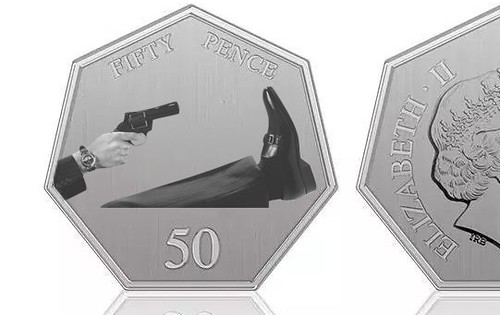
To read the complete article, see:
Twitter users mint new jokes over Brexit 50p coin
(https://www.theguardian.com/politics/2018/oct/29/twitter-users-mint-new-jokes-over-brexit-50p-coin)
EXECUTION SCENES IN NUMISMATICS
I didn't get this into last week's issue in time for Halloween, but it's a nice article from PCGS by Dylan Dominguez about scenes of executions in numismatics. Here's an excerpt - see the complete article online for more. -Editor
Since this week is Halloween, I wanted to dig into the dark side of numismatics and share with you some tokens that have an ominous past. These tokens were privately struck/minted in the late 18th century and early 19th century by companies in England, Anglesey, Wales, Scotland, and Ireland. Increasing populations and the Industrial Revolution created a shortage in small denomination coinage, and employees needed to be paid. Also, with the French Revolution still taking place at this time, tensions were high, and there was a hatred for many political figures at the time. One of these political figures was Thomas Paine. Born in England, in 1737, Thomas grew up to become a Philosopher, Author, and Political activist and even motivated the patriots to declare independence from Britain in 1776. Below are some examples of how Great Britain felt towards Thomas Paine and others.
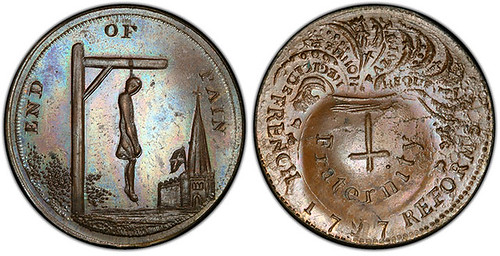
Obverse: Thomas Paine hanging from a gibbet with a church in the distance, “END OF PAIN†inscribed above.
Reverse: An upside-down cross with the word “FRATERNITY†inscribed below. “FRENCH REFORM†inscribed around “1797â€. Above “REGICIDE, ROBBERY, FALSITY, REQUISITION†Are inscribed in the waves coming from the cross.
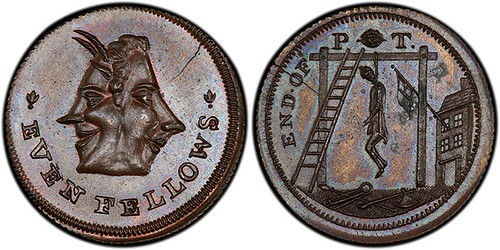
Obverse: Thomas Paine’s head looking right connected to the devil looking left. "EVEN FELLOWS" written below.
Reverse: Thomas Paine hanging, above an all-seeing eye looking forward with "End OF" inscribed around to the left of Thomas Paine’s initials "TP". A structure in the distance with the flag of England hanging down.

Obverse: Three figures hanging from a Gibbet "NOTED ADVOCATES FOR THE RIGHTS OF MEN" Around and 1796 below. This image is most likely Thomas pain and others who supported the revolution.
Reverse: "A WAY TO PREVENT KNAVES GETTING A TRICK" inscribed on the reverse. This text refers to a dishonest man trying to outwit or deceive someone.
To read the complete article, see:
The Dark Side of Numismatics – Scenes of Executions
(https://www.pcgs.com/news/the-dark-side-of-numismatics-scenes-of-executions)
PRESIDENT WOODROW WILSON MEDAL PUZZLE
Harry Waterson writes:
This puzzle uses front-face images of President Woodrow Wilson. The MCA Advisory published another puzzle I put together in September of left-profile images of Woodrow Wilson.
Match the obverses (A-F) with the correct reverses (1-6)

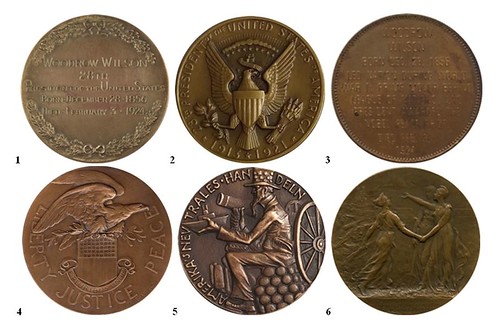
Great activity for Armistice Day. Who thinks they got it right? Answers next week. -Editor
WAFFLE CANCELLED MARTHA WASHINGTON EXPERIMENTAL QUARTER
While compiling my NUMISMATIC NUGGETS article this week I came across this great piece in the stock of error dealer Jon Sullivan. -Editor
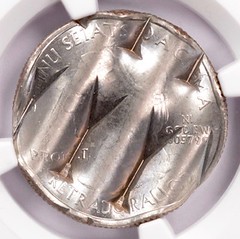

NGC (2011-2013) Martha Washington experimental quarter, waffle cancelled, and listed as J-2225 on U.S. Patterns.com.
The coin is an experimental Martha Washington design which was used in 2011-2013 for experimental testing of metals being done by the U.S. Mint for possible replacement of the metals used in our circulating coinage. The quarter design show here was tested in 9 metals, and this is one of them. It is listed as J-2225 on U.S. Patterns website: http://uspatterns.com/2012testpieces.html which briefly shows the 9 metals tested for the quarter design. This particular coin is the one struck on the normal "clad" quarter planchet.
Although the coin is waffle-cancelled, it is still desirable, since it is an example of the genuine Martha Washington clad experimental quarter. It is unique as of this writing, with no other examples known in collector hands.
Coin world wrote an article on this coin, which can be found here:
https://www.coinworld.com/news/us-coins/2018/10/waffle-cancelled-quarter-strike-in-collector-hands.all.html
SCIENTIST SOUGHT FOR BANK OF ENGLAND BANKNOTES
Arthur Shippee forwarded this BBC News article about a call to nominate a scientist to appear on a future Bank of England Banknote. Thanks. -Editor
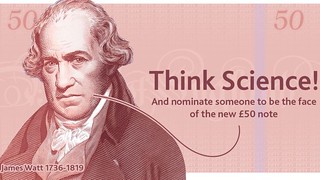 The new £50 note will feature a prominent British scientist, the Bank of England has announced, with the public being asked for nominations.
The new £50 note will feature a prominent British scientist, the Bank of England has announced, with the public being asked for nominations.
In addition to the Queen, the note will include the portrait of an eminent late scientist from fields such as biology, astronomy and medical research.
The public can offer suggestions on the Bank's website over the next six weeks.
The Bank's governor, Mark Carney, made the announcement at the Science Museum in London. "There is a wealth of individuals whose work has shaped how we think about the world and who continue to inspire people today," he said.
"Our banknotes are an opportunity to celebrate the diversity of UK society and highlight the contributions of its greatest citizens."
Nominations can include anyone who worked in any field of science including astronomy, biology, bio-technology, chemistry, engineering, mathematics, medical research, physics, technology or zoology, the Bank said.
To read the complete article, see:
New £50 note will feature a British scientist (https://www.bbc.com/news/business-46063097)
NORWAY'S NEWEST PIXELLATED BANKNOTES
The latest and last of Norway's new banknotes featuring pixellated graphics have been released to circulation. -Editor
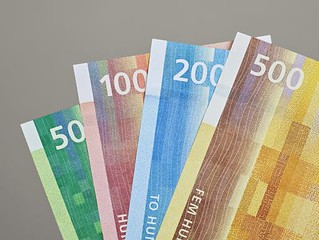 Norway has launched the country's new 50 and 500 kronor notes into circulation. Designed by Snøhetta, the revamped currency will join the graphic 100 and 200
notes launched in 2017 that were also penned by the firm as part of Norway's paper currency redesign.
Norway has launched the country's new 50 and 500 kronor notes into circulation. Designed by Snøhetta, the revamped currency will join the graphic 100 and 200
notes launched in 2017 that were also penned by the firm as part of Norway's paper currency redesign.
The Oslo studio's pixellated graphics were selected by country's central bank back in 2014. The abstract compositions celebrate landmarks along Norway's characteristic coastline, representing the strong relationship between land and sea.
The pixilated patterns, varying for each specific banknote, follow the Beaufort scale, which measures wind speed. For example, on the 50 NOK note the wind is gentle, represented by short, cubical shapes, while on the 1000 NOK note, the wind is strong, represented through sharp, long shapes.
The other side of the banknote features illustrations of traditional and contemporary sailing vessels, seascapes and marine life from the graphic design studio Metric Design. The final banknote for the 1000 kroner will join the others and come into circulation in 2019, completing the collection.
To read the complete article, see:
Norway's new bank notes designed by Snøhetta
come into circulation (https://archinect.com/news/article/150093416/norway-s-new-bank-notes-designed-by-sn-hetta-come-into-circulation)
To read the earlier E-Sylum article, see:
NORWAY'S NEW PIXEL BANKNOTES (http://www.coinbooks.org/esylum_v17n42a21.html)
BANKNOTE CUFFLINKS
Christmas is round the corner. For the numismatist who has everything, how about some banknote cufflinks? -Editor
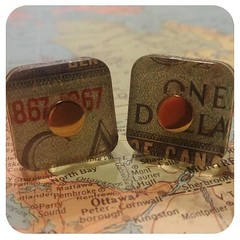 For many wearers, cufflinks created from coins are a wonderful way to show fashion and style for those attracted to particular countries, dates or even design
attributes. Banknotes too display style and have the added benefit of color and a larger canvas to express design. While coins have been incorporated in to cufflinks for years,
banknotes were never a consideration. Until now.
For many wearers, cufflinks created from coins are a wonderful way to show fashion and style for those attracted to particular countries, dates or even design
attributes. Banknotes too display style and have the added benefit of color and a larger canvas to express design. While coins have been incorporated in to cufflinks for years,
banknotes were never a consideration. Until now.
"This is something that's never been done before in a cufflink," says pranga's founder Daniel Feuer, "Coin cufflinks are relatively easy to create and we wanted something different and more unique." pranga & co is the first company ever to use real banknotes in the design of cufflinks. The initial release of the "Numis Collection" series features banknotes from over a dozen countries including Canada, Sweden, France and Ireland.
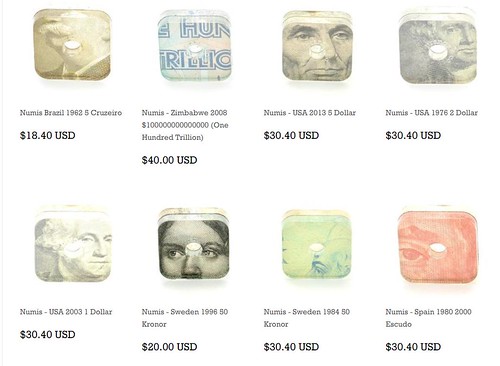
To read the complete article, see:
A World First – Banknote Cufflinks (http://www.digitaljournal.com/pr/4001420)

